
31
Jan
(Beyond Pesticides, January 31, 2014) Michael Skinner, Ph.D.,  author of the landmark study that links exposure to the insecticide DDT with multi-generational effects, ultimately contributing to obesity three generations down the line, is joining an impressive array of speakers at Beyond Pesticides’ 32nd National Pesticide Forum, April 11-12 in Portland, Oregon. Dr. Skinner’s groundbreaking research on transgenerational effects of pesticides has created quite a stir within the scientific community and backlash from the industry.
A professor in the School of Biological Sciences at Washington State University, Dr. Skinner has published over 240 peer-reviewed publications and has given over 237 invited symposia, plenary lectures and university seminars. His  research focuses on the investigation of gonadal growth and differentiation, with emphasis in the area of reproductive biology. His current research has demonstrated the ability of environmental toxicants to promote the epigenetic transgenerational inheritance of disease phenotypes due to abnormal germ line epigenetic programming in gonadal development.
Science Magazine has dubbed Dr. Skinner “The Epigenetics Heretic.” The article, published January 24, explores the controversy surrounding his recent findings, industry challenges to his research,  as well as the significance: “To those who don’t flatly dismiss Skinner’s findings, he has raised a tantalizing glimpse of a new phenomenon, one that should be explored further.” Skeptics are to be expected, Dr. Skinner tells Science, “This is probably going to be the biggest paradigm shift in science in recent history.” In fact, his scientific motto is, “If you are not doing something controversial, you are not doing something important.”
Hear Dr. Skinner discuss his important work, along with other top scientists, local and national activists and grassroots organizers at Advancing Sustainable Communities: People, pollinators and practices, the 32nd National Pesticide Forum, April 11-12, 2014 in Portland, Oregon. Register online now!
The 32nd National Forum provides an opportunity for grassroots advocates, scientists, and policy makers to interact and strategize on solutions that are protective of health and the environment. Keynote presentations, workshops, and plenary panels will focus on solutions to the decline of pollinators and other beneficials; strengthening organic agriculture; improving farmworker protection and agricultural justice; and creating healthy buildings, schools and homes. By working with a range environmental, health, consumer, and farm organizations, we expect to bring together a diverse crowd in order to share our efforts to build local, state and national strategies for strength, growth and health””in line with our conference theme, Advancing Sustainable Communities.
General admission is $40 for members and grassroots activists, $20 for students with current ID, and $75 for non-members (includes 1-year membership and totebag). Avoid the $5 late fee by registering before March 15th! In addition to access to all plenary sessions, discussions-based workshops, tour (by RSVP), and printed materials, registration also includes organic food and drink (breakfast, lunch, dinner and two receptions with hors d’oeuvres, beer and wine).  The forum will be held at the University Place Conference Center at Portland State University.Directions and hotel information are available on the Forum website.  Register online  or call 202-543-5450 to register by phone.
The conference is convened by Beyond Pesticides, Northwest Center for Alternatives to Pesticides (NCAP), and Portland State University’s Institute for Sustainable Solutions, and co-sponsored by local, state and regional public health and environmental organizations, including: Beyond Toxics, Center for Food Safety, PCUN (Pineros y Campesinos Unidos del Noroeste), and The Xerces Society. If your group is interested in co-sponsoring the forum please feel free to email us.
For more information on the program, including a full list of speakers and registration information, please see www.beyondpesticides.org/forum.
All unattributed positions and opinions in this piece are those of Beyond Pesticides
Posted in Alternatives/Organics, Announcements, Chemicals, Disease/Health Effects, Obesity, Oregon by: Beyond Pesticides
1 Comment
30
Jan
(Beyond Pesticides, January 30, 2014) With the U.S. House of Representatives’ passage of the Agriculture Act of 2014 (commonly known as the Farm Bill) yesterday, conventional farming allies and chemical agribusiness dealt a dangerous blow to children’s health protections and offered up yet another reason for consumers everywhere to support organic. The behind-closed-door amendment to the Farm Bill that appeared in neither the pre-conference House or Senate-passed versions of the Bill available to the public, orders the U.S. Environmental Protection Agency (EPA) to ignore its ruling that levels of fluoride left in food treated with the toxic fumigant sulfuryl fluoride are unsafe for consumers everywhere, especially children and infants.
Looking at the Numbers
Under the Food Quality Protection Act (FQPA), a law designed to provide stronger protections for infants and children from pesticides, EPA must consider the aggregate dose that children receive from pesticide residues along with the other “nonpesticidal” sources. In the case of sulfuryl fluoride, a fumigant used in closed structures such as barns, storage buildings, commercial warehouses, ships in port, and railroad cars and thus also found on their stored contents like grains and other crops, this is an important consideration because other sources of fluoride abound in the form of fluoridated water and dental products and from its natural presence in the environment.
Before 2004, the allowed tolerances for fluoride on certain foodstuffs was set at 7 parts per million (ppm), but in January 2004 after intensive lobbying by Dow Agrosciences, EPA approved the use of sulfuryl fluoride as a fumigant on raw food. Shortly thereafter, in July 2005 that approval was extended to all processed foods. To account for this new use, EPA moved to adjust the allowable dosage of fluoride for infants to a number five times higher than that set for adults.
Unwilling to stand by and let EPA set allowances at the behest of industry without considering that actual health impacts it was required to consider under the FQPA, Beyond Pesticides along with Fluoride Action Network and Environmental Working Group, filed a petition to the EPA in June 2006. The petition called for a “stay,” or immediate suspension, of all food uses of sulfuryl fluoride pending a full evidentiary hearing on the safety of the proposed allowances.
In 2011, EPA’s Office of Pesticide Programs could not dismiss the numbers. EPA proposed the withdrawal of sulfuryl fluoride tolerance because applications of sulfuryl fluoride when taken together or “in the aggregate” with the other sources of fluoride found that levels exceeded the safe reference doses ””especially in the case of infants and children.
The Numbers Haven’t Changed
With the latest Farm Bill provision, EPA cannot assess the total risk from fluoride exposure as it is supposed to do by law. Thus even though the level of safe tolerances remains unchanged, the Farm Bill now orders EPA to close its eyes to the other known sources of fluoride that make their way into children and infants mouths everywhere. In effect, this means that 70 ppm fluoride will be found in more than 99% of all processed foods, 125 ppm in wheat flour (which goes into cookies, cakes, bread and pizza) and a massive 900 ppm in powdered eggs. One third of the eggs sold in the U.S. come in powdered form and the accompanying 900 ppm is only a tad below the 1000 ppm””the level at which parents are told to keep away from children under six, use only pea-sized amount, and not to swallow.
Too Much Fluoride is Still Unsafe
If you think that fluoride is safe at these levels (and even under these levels), think again. Actually, in the case of fluoride, “thinking” is one of the major risks.
In a recent Harvard meta-analysis, which shows that out of 27 studies investigating the IQ in Chinese children living in areas with high natural levels of fluoride in the water, 26 showed a lowering of IQ with an average drop of 7 IQ points. The lowest level at which this occurred was 1.8 ppm, and even lower (0.88 ppm) when combined with borderline iodine deficiency.
Philippe Grandjean, one of the authors of the Harvard analysis puts these findings into perspective in his book, Only One Chance, explaining that a shift down of 5 IQ points doubles the number of mentally handicapped in the population and halve the number of exceptionally gifted in the population. This can have serious social consequences and also deliver a blow to the future of our competiveness in the global economy.
“These findings offer no adequate margin of safety to protect all our children from impaired intellectual development from the combined exposure to sulfuryl fluoride residues and other sources of fluoride. The thought that we are taking these risks to satisfy Dow’s thirst for profit is both intolerable socially, and highly shortsighted from an economic perspective,” says Professor Paul Connett,Ph.D., who heads up the Fluoride Action Network. “Our kids are already getting far too much fluoride as evidenced by the fact that 41 percent of all American children aged 12 through 15 have some form of dental fluorosis a tell-tale sign that they have experienced the early signs of fluoride poisoning,” he adds, citing 2010 Center for Disease Control (CDC) data.
But brain-power is not the only thing at risk. Fluoride is persistent and bioaccumulates in the human body, posing the risk of a number of health problems to the public, including arthritis, hip fractures, bone cancer, kidney damage, infertility, and brain disorders.
Alternatives and Organic
Though conventional farming and the chemical agribusiness would have American consumers, and their elected officials, believe that there are no alternatives to sulfuryl fluoride, but for an equally as problematic fumigant, methyl bromide, the fact is that only the U.S. and Australia apply this fumigant directly to food. “The rest of the world has shown that sulfuryl fluoride is not necessary for the safe storage and handling of our food supply, given the availability of other methods —including temperature manipulation (heating and cooling), atmospheric controls (low oxygen and fumigation with carbon dioxide), biological controls (pheromones), and less toxic chemical controls (diatomaceous earth), all successfully used in organic production,” notes Jay Feldman, executive director of Beyond Pesticides.
One solution that once again places the burden on parents and consumers to take matters of food safety into their own hands is to buy organic. Sulfuryl fluoride is a prohibited from use in and around organic food, as is methyl bromide. Supporting organic and keeping organic strong against constant attempts to weaken its standards provides families the only option to show legislators, regulators, and industry alike that protecting the health of children and all consumers matters.
For more information on the history of organic agriculture and why it is the best choice for your health and the environment, please see Beyond Pesticides’ Organic Food Program Page.
Source: Fluoride Action Network
All unattributed positions and opinions in this piece are those of Beyond Pesticides
Posted in Agriculture, Chemicals, Corporations, Dow Chemical, National Politics, Pesticide Regulation, sulfuryl fluoride by: Beyond Pesticides
1 Comment
29
Jan
(Beyond Pesticides, January 29, 2014) People with high levels of exposure to the banned insecticide DDT are four times more likely to have Alzheimer’s disease than people with low levels, according to a new study of patients in Georgia and Texas. The research is among the first to report a connection between Alzheimer’s disease, which is the world’s most common neurodegenerative disease, and chemicals in the environment.
The traces of the insecticide found in the study’s Alzheimer’s patients are comparable to the amounts found in most Americans today. Although it was banned more than 40 years ago in the U.S., DDT still persists in the environment worldwide and is still used today in developing countries for malaria abatement programs.
“Our findings suggest that genetically susceptible individuals with higher levels of DDT exposure may be more at risk,” said Jason Richardson, PhD, a Rutgers University researcher who led the study.
The case-control study consisting of existing samples from patients with Alzheimer’s disease and control participants from the Emory University Alzheimer’s Disease Research Center and the University of Texas Southwestern Medical School’s Alzheimer’s Disease Center measured serum levels of DDE in 79 control and 86 Alzheimer’s disease cases. Levels of DDE, a breakdown product of DDT, were 3.8 times higher in people who had the disease than in those who did not, according to the study, “Elevated Serum Pesticide Levels and Risk for Alzheimer Disease,” which was published in JAMA Neurology. Participants with the highest DDE levels were 4.18 times more likely to have Alzheimer’s than those with the lowest levels.
The researchers also found that people with both risk factors  —high exposure and genetic susceptibility—  “might have a more severe form of the disease,” Dr. Richardson said. Patients scored lower on a mental test if they had the highest DDE levels and a particular genetic variation associated with Alzheimer’s than if they had high DDE but did not have the genetic factor.
Seventy percent of the non-Alzheimer’s patients had detectable DDE in their blood, compared with 80 percent of the Alzheimer’s patients. Nationwide, 75 to 80 percent of all Americans tested have measurable levels in their blood. Because some of the Alzheimer’s patients had no DDE and some without the disease had high levels, the study “suggests that exposure to DDE may contribute to Alzheimer’s disease only in a subset of cases, perhaps those with genetic polymorphisms that render them more susceptible to DDT/DDE exposure,” the authors wrote.
More than 5 million people in the U.S. alone are living with Alzheimer’s, and cases are expected to triple over the next few decades. In recent decades, Alzheimer’s research has focused heavily on finding genetic causes of the disease. But fewer than half of cases can be blamed on genes alone, and researchers are now looking at how lifestyle and environmental factors may interact with genetic factors. According to Dr. Richardson, it is likely that any environmental exposures that may have contributed to the disease happened long before the patients had symptoms. Alzheimer’s is a slow-moving disease that develops over the course of decades. Because DDT takes many years to break down and leave the body, “results suggest that cumulative lifetime exposures may be important.”
The findings build upon previous research  in which elevated levels of DDE were detected in the blood of 20 Alzheimer’s patients. While only a few studies have looked at potential environmental risk factors for Alzheimer’s, researchers have found links between pesticides and Parkinson’s, another degenerative brain disease. It is unclear whether there are periods early in life during which exposures to certain chemicals in the environment would be more likely to increase a person’s risk of eventually developing Alzheimer’s.
DDT already has been linked in other studies to reduced fertility, diabetes, and other health effects. But little has been known about its potential effects on the brain. A recent study reports that DDT affects multiple generations, ultimately contributing to obesity three generations down the line. However, the adverse impacts to humans ””including cancer, reproductive disease, neurological disease, developmental problems, diabetes and now Alzheimer’s disease”” paint a cautionary tale that long-banned pesticides continue to impact human health and the environment.
The Pesticide Induced Diseases Database (PIDD) keeps track of the most recent studies related to pesticide exposure. For more information on the multiple harms pesticides can cause, see Beyond Pesticides’ PIDD pages on Alzheimer’s, Parkinson’s, cancer, and other diseases.
Source: Environmental Health News
All unattributed positions and opinions in this piece are those of Beyond Pesticides
Posted in Alzheimers's, Chemicals, DDT, Disease/Health Effects by: Beyond Pesticides
No Comments
28
Jan
Beyond Pesticides, January 28, 2014) In the latest attempt to suppress the voice of local communities and scuttle the implementation of laws to protect health and the environment, last week a bill was introduced in the Hawaii State House of Representatives that will preempt (block) local governments from restricting the use of hazardous pesticides and genetically engineered (GE) crops. Though House Bill 2506 is being promoted as the expansion of the state’s “Right-to-Farm Act,” the bill will prevent the implementation of new laws recently passed in Kauai and Hawaii County. Kauai Councilman Gary Hooser explained to The Garden Island, “Both of these bills take away 100 percent of the authority of the county to regulate agriculture, which includes pesticides. It is without question an attempt to nullify Ordinance 960 (formerly Bill 2491), as well as the ordinance passed on the Big Island.”
 Local communities in the Hawaiian Islands fought a number of hard-won battles last year against intrusions by agrichemical companies spraying pesticides and planting GE crops near where they work, live, and go to school. After massive outpourings of public support, numerous late-night council sessions, and overcoming a mayoral veto, Kauai County passed Bill 2491. Kauai’s Ordinance 960 requires public disclosure of pesticides and GE crop locations, buffer zones around sensitive environmental sites, such as schools, hospitals and shorelines, and an Environmental and Public Health Impacts Study on the utilization of pesticides and GE crops by the giant agrichemical companies on the island.
Local communities in the Hawaiian Islands fought a number of hard-won battles last year against intrusions by agrichemical companies spraying pesticides and planting GE crops near where they work, live, and go to school. After massive outpourings of public support, numerous late-night council sessions, and overcoming a mayoral veto, Kauai County passed Bill 2491. Kauai’s Ordinance 960 requires public disclosure of pesticides and GE crop locations, buffer zones around sensitive environmental sites, such as schools, hospitals and shorelines, and an Environmental and Public Health Impacts Study on the utilization of pesticides and GE crops by the giant agrichemical companies on the island.
On the heels of Kauai’s victory, Mayor Billy Kenoi of Hawaii’s Big Island signed Bill 113 into law, restricting the planting of any new GE crops. “With this new ordinance we are conveying that instead of global agribusiness corporations, we want to encourage and support community-based farming and ranching,” said the Mayor in a letter to the Hawaii County Council.
The Hawaiian Islands provide some of the most fertile growing conditions on the planet, allowing agrichemical companies to plant up to three seasons of corn in one year. However, along with the continuous planting of corn and other GE crops is the continuous use of herbicides that these crops are modified to withstand. GE agriculture puts farmers on the pesticide treadmill. After farmers begin routinely spraying herbicides, weeds develop resistance to the chemical, requiring increased amounts of herbicides. According to a 2012 study, the use of herbicides required to deal with resistant “superweeds” grew from 1.5 million pounds in 1999 to 90 million pounds in 2011. But it doesn’t stop there. Now, agrichemical companies have gone to the back of the toolshed, resorting to older and increasingly toxic herbicides such as 2,4-D, half of the mixture that made up the deadly defoliant Agent Orange, which was sprayed during the Vietnam War. The U.S. Department of Agriculture has recommended that these 2,4-D crops be allowed on to market despite evidence already showing resistance in certain areas of the county and serious concerns about human and environmental health.
Most herbicide-resistant GE crops don’t produce their own insecticide, like some GE crops do, so along with a regular dousing of herbicides is the frequent use of toxic insecticides such as chlopyrifos, a potent neurotoxin (banned for most residential use due to risks to children) that has been used on corn fields near schools in Kauai while children were in school. Concerned schoolteachers and parents have documented proof of this occurring in a Syngenta field despite assurances from the company that it would wait until after the school day is out. See the video here.
Kauai’s Ordinance 960 takes steps to prevent trespass by implementing commonsense, health-protective pesticide buffer zones around sensitive sites such as hospitals, schools, and neighborhoods. The ordinance promotes accountability by requiring agrichemical companies to disclose where they are spaying pesticides and planting GE crops. Hawaii County’s Bill 113 would also prevent pesticide incidents from occurring by stopping the growth of the agrichemical industry and their new, more dangerous GE crops on the Big Island.
State legislators should take heed and recognize the importance of these local ordinances. Advocates have argued that the “Right-to-Farm” for private profit should never trump a community’s right to freedom from hazardous chemicals.
Agrichemical companies are suing the Kauai County government to stop the implementation of Ordinance 960, claiming that the state law already preempts the county from taking action. However, as Beyond Pesticides pointed out in a recent Pesticides and You article entitled “State Preemption Law,” Hawaii is one of seven states that currently do not have regulations that would preempt local ordinances from enacting requirements more strict than the state’s. Hawaii House Bill 2506 would reverse that and roll back the right of local communities to take a stand against inadequate state and federal pesticide regulations. You can submit testimony on HB2506 by going to this link.
For more information on the fight for pesticide protections in the Hawaiian Islands, see Beyond Pesticides’ past Daily News articles and read Beyond Pesticides’ testimony on Bill 2491. For more information on the failed promises of GE agriculture, read “Ready or Not, Genetically Engineered Crops Explode on Market,” or see Beyond Pesticides’ website on Genetic Engineering.
Source: The Garden Island
Image Source: Flikr
All unattributed positions and opinions in this piece are those of Beyond Pesticides
Posted in 2,4-D, Agriculture, Chemicals, Genetic Engineering, Hawaii, Pesticide Drift, Pesticide Regulation, State/Local by: Beyond Pesticides
No Comments
27
Jan
(Beyond Pesticides, January 27, 2014) During the worst drought that California has seen in 100 years , goats are being used to clear brush, a fire hazard,  on several acres  of city property in Anaheim, California. This is not the first city in California to use goats to limit the dangers of wildfires; Auburn California also used them last September. Goats are an extremely efficient way to clear brush and are used in many landscape settings beyond fire hazardous brush.
During the week of January 13-17, Anaheim Fire and Rescue and the Department of Public Works contracted Environmental Land Management to clear six acres of brush along a right-of-way  using close to 100 goats. This method of ecological brush control was specifically chosen because it is a safer way to eliminate the wildfire dangers that dry brush can create.  Other common methods of brush control, such as mowing, can cause problems in dry conditions by creating sparks and inadvertently start fires. The goats were also used in hilly areas of East Anaheim, which are difficult to clear using mowers. This method of brush clearing is extremely efficient and contracting goats cost the city only $5,000 dollars, one-third less than mechanical methods. The use of goats was also enjoyed by the community.  According to a city press release, the animals gave “spectators a fun, visual experience as the goats enjoy their meal.”
Goats have been used before in California to manage fire prone areas. In September, the utility company Pacific Gas and Electric (PG&E) Â used over 900 goats to clear weeds and dried brush on 100 acres of its property in Auburn, California. Four years ago a fire in Auburn, California burned 340 acres, destroying 66 homes and 3 commercial buildings. Residents were worried that another fire was possible on the hillside that was grazed by the goats.
PG&E land consultant Jack Harvey was quoted in a PG&E press release saying, “This project has been very successful and economical.  Given that the goats have exceeded in meeting the intent I hope to see this program used more in the future.”
Goats have also been used for general weed management. Recently, goats were used to control poison ivy, ground cover, vines and other invasive weeds at the Congressional Cemetery in  Washington, D.C.  Goats have also been used in  Durango, Colorado  to manage weeds, restore soil, and improve land quality on a 65-acre oil field, and at  airports  in Chicago, Atlanta, and San Francisco, where overgrown property on hills and in standing water are  difficult to reach  by machinery and pesticide applicators.
Beyond Pesticides has long been an advocate for the use of goats and grazing animals as an ecological solution for weed management. Goats are often more efficient at eradicating weeds, and are always more environmentally sustainable than using harmful pesticides and chemicals. Goats consume everything from shrubs and weeds to thistles and poisonous plants. They can graze up hills and down gullies that are too steep for mowers or machines. As they eat, the goats ensure that weeds do not go to seed. By snapping off flower heads and eating off all the leaves, weeds cannot photosynthesize sunlight to build a root system.
For more information on natural, non-chemical land management strategies, see Beyond Pesticides’  Lawns and Landscapes  and  Invasive Weed Management pages. Lani Malmberg, a Beyond Pesticides board member and owner of  Ewe4ic Ecological Services, a goat grazing service, will be speaking at Beyond Pesticides’  32nd National Pesticide Forum,  Advancing Sustainable Communities —People, pollinators and practices. The annual conference will be held in Portland, Oregon April 11-12, 2014, at Portland State University in conjunction with Northwest Center for Alternatives to Pesticides and Portland State University’s Institute for Sustainable Solutions.   For more information, see the  National Pesticide Forum website.
Source: NBC Los Angles
All unattributed positions and opinions in this piece are those of Beyond Pesticides
Posted in Alternatives/Organics, Integrated and Organic Pest Management, State/Local, Wildlife/Endangered Sp. by: Beyond Pesticides
No Comments
24
Jan
(Beyond Pesticides, January 25, 2014) U.S. Representative Peter DeFazio (D-OR) joined other members of Congress, along with more than 200 businesses and organizations, including Beyond Pesticides, in petitioning President Obama to adopt labeling requirements for genetically engineered (GE) foods. The letter encourages the president to fulfill his campaign pledge made in 2007 to require the Food and Drug Administration (FDA) to adopt a national mandatory labeling system.
“It’s time the FDA’s policies reflected 21st century food technologies,” said Rep DeFazio in a press conference last Thursday. “After all, twenty years ago they didn’t have corn that could produce its own insecticides.”
In April 2013, Rep. DeFazio and Senator Barbara Boxer (D-CA) introduced bipartisan legislation that requires FDA to label GE food, under the proposed Genetically Engineered Food Right-to-Know Act. The bill now has 50 cosponsors. “Two state legislatures have already approved GE labeling and more than 20 other states are considering GE labeling laws,” the letter reads, referring to the GE labeling laws passed in Connecticut and Maine.
“Plain and simple, this is about consumer rights,” said Rep. DeFazio. “People should have the ability to make an informed choice about what they feed their family and we know it’s not an impossible request of food manufacturers, because they already label GMOs in more than sixty countries. Food manufacturers can and should offer that same standard right here in the U.S.”
Many countries, including the European Union and Japan, have banned planting of GE crops outright and more than 60 other countries already require GE labeling. “We know it can be done,” said Rep. DeFazio. Consumers have a right to know whether the foods they buy contain GE ingredients not only because of concerns over the safety of eating GE food, but also because of the direct and indirect effects of GE agriculture on the environment, wildlife, and the human health. Repeated spraying herbicides, particularly glyphosate, the active ingredient in Roundup, demonstrably destroys refuge areas for beneficial insects, directly harms amphibians, and leads to resistance in weed species the GE technology was intended to control. With the significant issue of herbicide resistance, farmers have resorted to increasingly toxic combinations of chemicals, despite the presence of organic management practices that are  protective of human health and the environment and produce the same yield. Thus, for a multitude of reasons, consumers have the right to know the ingredients in the products they are purchasing.
In the meantime, the best way to avoid food with GE ingredients is to buy organic. Under organic certification standards, GE organisms are prohibited.  For this and many other reasons, organic products are the right choice for consumers. For more information on GE foods and labeling issues, see Beyond Pesticides’  Genetic Engineering website.
All unattributed positions and opinions in this piece are those of Beyond Pesticides
Sources: Statesman Journal, Oregon Public Broadcasting
Posted in Genetic Engineering, Labeling by: Beyond Pesticides
No Comments
23
Jan
(Beyond Pesticides, January 23, 2014) Putting ideas into action, an Oregon-based restoration nonprofit group, Ocean Blue Project, is harnessing the power of mushrooms to clean up pesticides and other pollutants that plague Oregon and national waterways. Yes, mushrooms.
 The test project launched Sunday, January 19 on the banks of Sequoia Creek, a tributary to the Willamette River. Using recycled burlap bags filled with used coffee grounds, straw, and yellow oyster mushroom spawn, the purpose of the unusual potpourri will be to harness the extremely effective filtering capabilities of mycelium.
The test project launched Sunday, January 19 on the banks of Sequoia Creek, a tributary to the Willamette River. Using recycled burlap bags filled with used coffee grounds, straw, and yellow oyster mushroom spawn, the purpose of the unusual potpourri will be to harness the extremely effective filtering capabilities of mycelium.
A kind of root system for fungi, mycelium demonstrate a wide variety of biological powers, from breaking down oil, pesticides, and harmful bacteria to acting as natural pesticides against some of the most problematic pests.
Paul Stamets, a leading expert on the power of mushrooms and former speaker at Beyond Pesticides’ National Pesticide Forum in 2006, has a word for the natural properties of fungi to fight human-made pollution: mycorestoration. As Mr. Stamets explained to Discover Magazine in 2013, “Oyster mushrooms, for example, can digest the complex hydrocarbons in wood, so they can also be used to break down petroleum byproducts. Garden Giants use their mycelia to trap and eat bacteria, so they can filter E. coli from agricultural runoff.”
Richard Arterbury, president of the Ocean Blue Project, agrees. Mr. Arterbury explained to reporters at Corvallis Gazette-Times, that the technique could potentially be a low-cost way to use biologic processes to reduce pollution in waterways. Mr. Arterbury thinks the project has huge potential. “If you put enough of these bags by the Willamette River it could potentially change the river,” he said.
Pesticides in Water
And change is needed not just in Oregon. Waterways in the U.S. are increasingly imperiled from various agents, including agricultural and industrial discharges, nutrient loading (nitrogen and phosphorus), and biological agents such as pathogens. Pesticides discharged into our nation’s rivers, lakes and streams can harm or kill fish and amphibians. These toxicants have the potential to accumulate in the fish we eat and the water we drink. As pesticide use escalates and waterways and drinking water become increasingly polluted with unregulated contaminants like pesticides and other toxicants, low-cost and natural alternatives for restoring waterways are desperately needed. For more information on the impacts of pesticides on waterways and what you can do, see Beyond Pesticides’ Threatened Waters webpage.
Discussing innovative new practices and alternatives to address pesticide contamination will be just one of the many exciting topics at this year’s 32nd National Pesticide Forum, Advancing Sustainable Communities: People, Pollinators and Practices. Please join Beyond Pesticides, Northwest Center for Alternatives to Pesticides and Portland State University’s Institute for Sustainable Solutions April 11-12, 2014 in Portland, Oregon, to help communities everywhere make strides in reducing pesticides and moving communities everywhere towards a more sustainable future.
Source: Corvallis Gazette-Times, TED
Photo Courtesy: Jesse Skoubo, Corvallis Gazette-Times
All unattributed positions and opinions in this piece are those of Beyond Pesticides.
Posted in Alternatives/Organics, Oregon, State/Local, Water, Wildlife/Endangered Sp. by: Beyond Pesticides
1 Comment
22
Jan
(Beyond Pesticides, January 22, 2014) Â Exposure to a widely used pesticide causes worker bumblebees to grow less and then hatch out at a smaller size, according to a new study by Royal Holloway University of London.
The research, published this week in the Journal of Applied Ecology, reveals that prolonged exposure to a pyrethroid pesticide, which is used on flowering crops to prevent insect damage, reduces the size of individual bees produced by a colony.
The researchers, Gemma Baron, Dr Nigel Raine and Professor Mark Brown from the School of Biological Sciences at Royal Holloway worked with colonies of bumblebees in their laboratory and exposed half of them to the pesticide.
The scientists tracked how the bee colonies grew over a four month period, recording their size and weighing bees on micro-scales, as well as monitoring the number of queens and male bees produced by the colony.
“We already know that larger bumblebees are more effective at foraging. Our result, revealing that this pesticide causes bees to hatch out at a smaller size, is of concern as the size of workers produced in the field is likely to be a key component of colony success, with smaller bees being less efficient at collecting nectar and pollen from flowers,” says researcher Gemma Baron from Royal Holloway.
The study is the first to examine the impact of pyrethroid pesticides across the entire lifecycle of bumblebees. The topical research is at the heart of a national  Bee Health Conference  running in London from Wednesday to Friday this week (22-24 January 2014).
Professor Mark Brown said, “Bumblebees are essential to our food chain so it’s critical we understand how wild bees might be impacted by the chemicals we are putting into the environment. We know we have to protect plants from insect damage but we need to find a balance and ensure we are not harming our bees in the process.”
Given the current EU moratorium on the use of three neonicotinoid pesticides, the use of other classes of pesticide, including pyrethroids, is likely to increase in chemical-dependent land management systems.
Dr Nigel Raine, who is an Invited speaker at this week’s bee conference, said, “Our work provides a significant step forward in understanding the detrimental impact of pesticides other than neonicotinoids on wild bees. Further studies using  colonies  placed in the field are essential to understand the full impacts, and conducting such studies needs to be a priority for scientists and governments.”
The study was funded by a Natural Environment Research Council (NERC) PhD studentship, and the Insect Pollinators Initiative (joint-funded by the Biotechnology and Biological Sciences Research Council (BBSRC), Defra, NERC, the Scottish Government and the Wellcome Trust. It is managed under the auspices of the Living with Environmental Change (LWEC) partnership). Â Contact: Paul Teed, Â [email protected], Â 01-784-443-967, Â Royal Holloway, University of London.
Source: Royal Holloway, University of London
Posted in Agriculture, Chemicals, Pollinators by: Beyond Pesticides
No Comments
21
Jan
(Beyond Pesticides, January 21, 2013) Two Minnesota state agencies are creating plans they say will  address declining pollinator populations in the state. The Minnesota Department of Natural Resources (DNR) is developing best management practices for managing and increasing pollinator habitat and the Minnesota Department of Agriculture (MDA) is developing a plan to study the impacts of neonicotinoid pesticides on pollinators. Critics of the state’s plan say that there is no more need to study the effects of neonicotinoids because the negative impacts they have on pollinators has been already studied extensively.
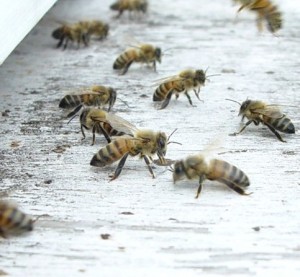
The DNR is developing guidelines to improve habitat for pollinator insects. Recent reports show that  the planting of herbicide-resistant genetically engineered (GE) crops is responsible for habitat loss and the decline of native pollinators like the Monarch butterfly. The expansion of glyphosate tolerant GE corn and soybean cropland has allowed farmers to kill milkweed, the primary source of food for Monarchs, which historically grew between crop rows in the Midwest. A rapid expansion of farmland ””more than 25 million new acres in the U.S. since 2007”” has also eaten away grasslands and conservation reserves that supplied the Monarchs with milkweed. DNR officials have indicated this guide could change where grassland is burned or mowed, or add more plants as habitats for pollinators. DNR may also work in the future with the Minnesota Department of Transportation (MnDOT) to incorporate native wildflowers into roadside right-of-ways to increase pollinator habitat.
The MDA also gave the Legislature a report on Wednesday outlining, among other issues, a plan to study the use of neonicotinoids and their impacts on pollinators. The report was developed in response to the 2013 Pollinator Legislation H.F. 976. The specific risk neonicotinoids pose to pollinators will be the focus of the review, and will include a summary of research into neonicotinoid hazards to a variety of pollinator species in crop production and garden/landscape settings, and the related risks of biodiversity maintenance and ecological balance in natural ecosystems. The review will also include an overview of the effects residue accumulation in pollen, nectar, guttation droplets, and other pollinator exposure pathways associated with treated plants. According to MDA, special chemical reviews can take six months or more. Though it is important for states to take action to study these chemicals beyond the flawed Environmental Protection Agency (EPA) registration process, extensive scientific research has already assessed the hazards that  these chemicals pose to pollinator species.
Steve Ellis, owner of Old Mill Honey Co. in Minnesota, expressed his frustration in a Public New Service article, saying, “We’ve already got 150 scientific papers that implicate the neonicitinoids in the bee decline. I’m not really sure we need more than that. It’s time in the United States that we took action, and I would hope that the Minnesota Department of Agriculture would step up to the plate and become proactive.”
Neonicotinoids are a relatively new class of insecticides that share a common mode of action that affect the central nervous system of insects, resulting in paralysis and death. They include imidacloprid, acetamiprid, clothianidin, dinotefuran, nithiazine, thiacloprid and thiamethoxam. Currently, neonicotinoid insecticides are the most widely used class of insecticides in the world and compromise about 25% of the global agrichemical market.
Neonicotinoids are systemic, meaning that as the plant grows the pesticide becomes incorporated into the plant. When honey bees and other pollinators forage and collect pollen or nectar, or drink from what are termed “guttation” (water) droplets emitted from neonicotinoid-incorporated crops, they are exposed to sublethal doses of the chemical. At this level, the pesticides don’t kill bees outright. Instead, they impair bees’ ability to learn, to find their way back to the hive, to collect food, to produce new queens, and to mount an effective immune response.
Beyond Pesticides through its  BEE Protective  campaign works with national and local groups to protect honey bees and other pollinators from pesticides and contaminated landscapes. As part of this campaign, Recently, Beyond Pesticides, as part of coalition, launched a  national advertising campaign  to raise awareness of pollinator declines and urge EPA to stop stalling by enacting substantive restrictions on the use of bee-harming pesticides. To support our efforts to restrict bee-toxic pesticides, visit  save-bees.org  and sign the petition to EPA Administrator Gina McCarthy.
Source: CrookstonTimes
All unattributed positions and opinions in this piece are those of Beyond Pesticides.
Posted in Agriculture, Chemicals, Minnesota, neonicotinoids, Pollinators, State/Local, Wildlife/Endangered Sp. by: Beyond Pesticides
1 Comment
17
Jan
(Beyond Pesticides, January 17, 2014) A new economic study, Would banning atrazine benefit farmers?, published in the International Journal of Occupational and Environmental Health demonstrates that eliminating the herbicide atrazine, widely used on U.S. corn crops, will economically benefit corn growers. The study examines the research produced by the Atrazine Benefits Team (ABT), a group assembled by atrazine manufacturer Syngenta, revealing that the industry-funded studies significantly overestimate the benefits of atrazine without considering the value of nonchemical weed management techniques.
Research, led by Frank Ackerman, PhD., professor at Tufts University in the Global Development and Environment Institute, questions the economic viability of atrazine in Syngenta’s study. Researchers critically review five papers released by ABT in 2011, which claim that the withdrawal of atrazine would diminish corn yields by 4.4%, increasing corn prices by 8%. Using these assumptions, Dr. Ackerman and his team calculated that corn growers’ revenue would actually increase by 3.2%, providing a total of $1.7 billion to farmers and the U.S. economy with minimal price changes for consumers. In short, because of price elasticity, eliminating atrazine would improve farmer revenues.
According to the study, “The result [of an atrazine ban] would be an increase in corn growers’ revenues, equal to US$1 ·7 billion annually under ABT assumptions. Price impacts on consumers would be minimal: at current levels of ethanol production and use, gasoline prices would rise by no more than US$0 ·03 per gallon; beef prices would rise by an estimated US$0 ·01 for a 4-ounce hamburger and US$0 ·05 for an 8-ounce steak. Thus withdrawal of atrazine would boost farm revenues, while only changing consumer prices by pennies.”
Additionally, the paper criticizes ABT conclusions that overstated the effectiveness of atrazine and completely ignored non-chemical alternatives. Indeed, the widespread use of chemicals like atrazine, according to the study, “has created a situation favoring the emergence and proliferation of herbicide resistant weeds.”  The study finds,  “Multiple factors, including the spread of resistance to both glyphosate and atrazine, the desire to reduce chemical costs, and concerns about health and ecosystem impacts of the herbicides, have led producers to consider low chemical or no- chemical IWM [integrated weed management] strategies.” These established and practical alternatives, however, were simply not considered by ABT’s analysis.
Thus, the study concludes that eliminating atrazine and opting for proven alternatives would not only improve farmer revenues but also avoid costs to human health and the environment. “The winners,” the authors  conclude, “in an atrazine free future would include farm worker, farmers and their families, and other who are exposed to atrazine either directly from field uses or indirectly from contaminated tap water along with natural ecosystem that are currently damaged by atrazine.”
Indeed, because atrazine is used on up to 85% of all corn crops in the U.S. each year ””second only to the active ingredient glyphosate”” it is pervasive within the environment, including municipal drinking water. It is the most commonly detected pesticide in rivers, streams and wells, with an estimated 76.4 million pounds of atrazine applied in the U.S. annually. It has been linked to a myriad of environmental concerns and health problems in humans, including disruption of hormone activity, birth defects, and cancer, as well as effects on human reproductive systems, as we have noted.
In 2011, EPA published a petition to ban atrazine. Beyond Pesticides submitted comments last year in support of this petition in which we outline in detail the numerous reasons that this chemical is harmful and unnecessary. Syngenta was forced to pay $105 million in 2012 as part of a settlement to reimburse community water systems in 45 states that had to filter atrazine from its drinking water. However, according to reports on the settlement, Syngenta is neither accepting contamination responsibility nor acknowledging hazards associated with its product.
Currently, you can avoid eating food grown with  harmful synthetic pesticides by eating organic. For this and many other reasons, organic products are the right choice for consumers. For more information on organic agriculture, visit Beyond Pesticides’ Organic Agriculture program page.
All unattributed positions and opinions in this piece are those of Beyond Pesticides.
Source: International Journal of Occupational and Environmental Health
Posted in Agriculture, Atrazine, Chemicals, Corporations, Resistance, Syngenta, Water by: Beyond Pesticides
1 Comment
16
Jan
(Beyond Pesticides, January 16, 2014) Researchers in Norway recently released a new study giving organic consumers and anti-genetically engineered (GE) crop advocates another few solid reasons to promote organic and continue the fight against engineered crops. Â Findings from the study demonstrate that not only do soybeans grown using organic cultivation practices provide the healthiest nutritional profile of the three classes of soybeans studied, but GE soybeans also retain glyphosate residues at higher levels than their conventional, non-GE soybean counterparts.
 In Compositional differences in soybeans on the market: Glyphosate accumulates in Roundup Ready GM soybeans (Soy Study), Thomas Bøhn of Genøk, Centre for Biosafety and his team of researcher examined 31 batches of soybeans””all grown in the United States.  The batches were separated into three categories: (1) GE, glyphosate-tolerant soy (GE-soy); (2) unmodified soy cultivated using conventional ”˜chemical’ practices; and (3) unmodified soy cultivated using organic practices. Among the three categories, all individual soybean samples were analyzed for their nutritional content, including total protein, total fat, dry matter, starch, ash, minerals, trace elements, vitamin B6, amino acid and fatty acid composition, in addition to the relevant pesticides used on the samples during cultivation.
In Compositional differences in soybeans on the market: Glyphosate accumulates in Roundup Ready GM soybeans (Soy Study), Thomas Bøhn of Genøk, Centre for Biosafety and his team of researcher examined 31 batches of soybeans””all grown in the United States.  The batches were separated into three categories: (1) GE, glyphosate-tolerant soy (GE-soy); (2) unmodified soy cultivated using conventional ”˜chemical’ practices; and (3) unmodified soy cultivated using organic practices. Among the three categories, all individual soybean samples were analyzed for their nutritional content, including total protein, total fat, dry matter, starch, ash, minerals, trace elements, vitamin B6, amino acid and fatty acid composition, in addition to the relevant pesticides used on the samples during cultivation.
The study selected soybeans as the target crop because of the prevalence of GE-soy in both U.S. and global production yields.  “Globally, glyphosate-tolerant GE soy is the number one GE crop plant,” the Soy Study notes.  “In 2011—2012, soybeans were planted on about 30 million hectares in the [U.S.], with Roundup Ready GE soy contributing 93—94% of the production. . . .Globally, Roundup Ready GE soybeans contributed to 75% of the total soy production in 2011.”
Glyphosate is one of the most popular weedkillers in both the U.S. and the world and also the active ingredient in Roundup ””the leading glyphosate product developed by Monsanto. Known as “Roundup Ready,” GE soybeans, corn, cotton, and other crops have been genetically altered and patented by Monsanto to be glyphosate-tolerant. Whether a crop stems from a Roundup Ready seed or not, glyphosate is used in almost all agricultural areas of the U.S., as well as on an international scale, in conventional, non-organic farming operations.  Certified organic crops cannot use herbicides or most pesticides.
The Soy Study finds that organic soy shows the healthiest nutritional profile of the three soy categories, with more sugars, such as glucose, fructose, sucrose and maltose, significantly more total protein, zinc and less fiber than both conventional and GE-soy. Organic soybeans also contained less total saturated fat and total omega-6 fatty acids than both conventional and GE-soy. Recent studies of organic whole milk found similar results, with the added finding of increased omega-3 fatty acids in the organic milk samples tested.
Concerning glyphosate-residues, the study challenged industry-assertions that GE-crops retain fewer pesticide residues than non-GE, conventional crops and require less application of pesticides. Instead, the Soy Study reveals that GE-soy samples are the only category to contain glyphosate residues at elevated  levels.
Soy Study researchers speculate that, “The increased use of glyphosate on Roundup Ready soybeans in the U.S., contributing to the selection of glyphosate-tolerant weeds, with a response of increased doses and/or more applications used per season, may explain the observed plant tissue accumulation of glyphosate.”  In other words, because of the increased use of herbicides like glyphosate, herbicide-resistant weeds are increasing the need for greater and greater amounts of herbicides.
Do We Need to Worry About Glyphosate?
If readers are wondering whether glyphosate is really a problem pesticide, then the answer is a short and simple, “Yes.” A dangerous pesticide, glyphosate has been linked to a number of serious human health effects, including increased cancer risks, neurotoxicity, and  birth defects, as well as eye, skin, and respiratory irritation. Inert ingredients in Roundup pose significant risks as well, with studies linking polyoxyethyleneamine (POEA) to the killing of human embryonic cells. In 2013, researchers  at the Massachusetts Institute of Technology (MIT) also concluded after an extensive review of the large body of scientific literature on the toxics effects of glyphosate that the herbicide can enhance the negative effects of other environmental toxicants on the body and that this has been a critically overlooked component in research on glyphosates’ toxicity to mammals.
The Soy Study adds to the ever-growing pile of scientific research supporting the both personal and societal benefits of organic agricultural practices and provides yet another reason to raise a cautionary brow to the use of GE crops. Â Because certified organic products cannot use GE crops or most pesticides, it is important to Keep Organic Strong and buy organic to show consumer support for the standards and benefits organic practices maintain.
Source: Science Direct
All unattributed positions and opinions in this piece are those of Beyond Pesticides.
Posted in Agriculture, Alternatives/Organics, Chemicals, Corporations, Genetic Engineering, Glyphosate, Monsanto by: Beyond Pesticides
1 Comment
15
Jan
(Beyond Pesticides, January 15, 2013) The U.S. Supreme Court issued a decision on Monday  in the landmark federal lawsuit Organic Seed Growers and Trade Association et al v. Monsanto, limiting the ability of farmers to protect themselves from genetic drift. An earlier Appeals Court decision in the case acknowledged genetic drift as inevitable and evoked a public  commitment from Monsanto that it would not sue farmers faced with contamination of crops containing “trace amounts” of the company’s patented genes.  In the past, Monsanto has claimed that farmers were responsible and liable for its genetic property being found on land farmed by farmers who did not pay to cultivate the company’s genetically engineered crop.
The Supreme Court refused to hear an appeal and reinstate the suit, denying farmers the right to argue their case in court and gain greater protection from potential abuse by the agrichemical and genetic engineering giant, Monsanto. Additionally, the high court decision dashes the hopes of family farmers who sought the opportunity to prove in court Monsanto’s genetically engineered seed patents are invalid.
 The case, originally filed on behalf of several plaintiffs on March 29, 2011, Organic Seed Growers & Trade Association, et al. v. Monsanto, challenges Monsanto’s patents on genetically modified (GM) seed. The plaintiffs filed this lawsuit to shield farmers from being sued for patent infringement by Monsanto should they become contaminated by drift of the company’s genetically engineered seed, a legal strategy Monsanto has been pursuing for years. In 2012, a U.S. District Court Judge dismissed the case denying farmers the right to seek legal protection from one of the world’s foremost patent bullies. An appeal was filed a few months later in the U.S. Court of Appeals seeking to reinstate the case. In June 2013, the Court of Appeals for the Federal Circuit ruled the plaintiffs were not entitled to bring a lawsuit to protect themselves from Monsanto’s transgenic seed patents, affirming the previous court’s 2012 decision that the plaintiffs did not present a sufficient controversy to warrant adjudication by the courts. The Appeals Court decision is considered a partial victory for the plaintiffs because of the acknowledgement of drift and Monsanto’s promise not to sue farmers for “trace amounts” of contamination of crops containing its patented genes.
The case, originally filed on behalf of several plaintiffs on March 29, 2011, Organic Seed Growers & Trade Association, et al. v. Monsanto, challenges Monsanto’s patents on genetically modified (GM) seed. The plaintiffs filed this lawsuit to shield farmers from being sued for patent infringement by Monsanto should they become contaminated by drift of the company’s genetically engineered seed, a legal strategy Monsanto has been pursuing for years. In 2012, a U.S. District Court Judge dismissed the case denying farmers the right to seek legal protection from one of the world’s foremost patent bullies. An appeal was filed a few months later in the U.S. Court of Appeals seeking to reinstate the case. In June 2013, the Court of Appeals for the Federal Circuit ruled the plaintiffs were not entitled to bring a lawsuit to protect themselves from Monsanto’s transgenic seed patents, affirming the previous court’s 2012 decision that the plaintiffs did not present a sufficient controversy to warrant adjudication by the courts. The Appeals Court decision is considered a partial victory for the plaintiffs because of the acknowledgement of drift and Monsanto’s promise not to sue farmers for “trace amounts” of contamination of crops containing its patented genes.
“While the Supreme Court’s decision to not give organic and other non-GMO farmers the right to seek preemptive protection from Monsanto’s patents at this time is disappointing, it should not be misinterpreted as meaning that Monsanto has the right to bring such suits,” said Daniel Ravicher, Executive Director of the Public Patent Foundation (PUBPAT) and lead counsel to the plaintiffs in OSGATA et al v. Monsanto. “Indeed, in light of the Court of Appeals decision, Monsanto may not sue any contaminated farmer for patent infringement if the level of contamination is less than one percent. For farmers contaminated by more than one percent, perhaps a day will come to address whether Monsanto’s patents may be asserted against them. We are confident that if the courts ever hear such a case, they will rule for the non-GMO farmers.”
The Organic Seed plaintiffs’ complaint details Monsanto’s abusive business and litigation tactics that have put several farmers and independent seed companies out of business. It also detailed Monsanto’s history of ruthless patent enforcement, going so far as investigating hundreds of farmers each year for patent infringement. The plaintiffs further detailed the harms caused to society by Monsanto’s GMO seed, including the proliferation of herbicide-resistant “superweeds” and environmental pollution, and sought Court protection under the Declaratory Judgment Act that should they become the innocent victims of contamination by Monsanto’s patented gene-splice technology they could not perversely be sued for patent infringement.
“The Supreme Court failed to grasp the extreme predicament family farmers find themselves in,” said Maine organic seed farmer Jim Gerritsen, President of lead plaintiff OSGATA. “The Court of Appeals agreed our case had merit.  However, the safeguards they ordered are insufficient to protect our farms and our families. This high court which gave corporations the ability to patent life forms in 1980, and under Citizens United in 2010 gave corporations the power to buy their way to election victories, has now in 2014 denied farmers the basic right of protecting themselves from the notorious patent bully Monsanto.”
In a related situation, Canadian soybean farmer Stephen Webster of Ontario experienced just how abusive Monsanto can be in the treatment of innocent contamination victims. Through no fault of his own Mr. Webster, who farms with his elderly father, had his 2012 identify-preserved (IP) non-GMO soybean crop contaminated by Monsanto’s patented genetically engineered seed. Their soybeans were ruined for export to specialty markets in Japan. “First Monsanto claimed we had too many bees and that we were at fault for the contaminated crop,” said Mr. Webster. “Then they threatened to run up $100,000 in legal bills that we would have to pay.” Tragically, Mr. Webster’s story is the norm in farm country, with Monsanto using its extreme economic power to silence family farmers even before they can legally defend themselves.
Monsanto’s history of aggressive investigations and lawsuits brought against farmers in America has been a source of concern for organic and non-GMO agricultural producers since Monsanto’s first lawsuit brought against a farmer in the mid-”˜90s. Since then, 144 farmers have had lawsuits filed against them by Monsanto for alleged violations of their patented seed technology. Monsanto has sued more than 700 additional farmers who have settled out-of-court, rather than face Monsanto’s belligerent, and well-financed, litigious actions. Seed contamination and pollen drift from genetically engineered crops often migrate to neighboring fields. If Monsanto’s seed technology is found on a farmer’s land without a contract, the farmer can be found liable for patent infringement. Genetic contamination of organic and non-genetically engineered crops by pollen that originates from genetically engineered crops and drifts to a neighboring field has been irrefutably confirmed by scientific research. It is especially prevalent with the wind-pollinated corn and insect-pollinated canola, whose pollen can travel for two or more miles. Such contamination has proven extremely costly to farmers raising organic and non-genetically engineered crops whose loads are rejected by buyers when trace levels of contamination are detected.
Notably, none of the plaintiffs are customers of Monsanto. None have signed licensing agreements with Monsanto. The plaintiffs do not want Monsanto’s seed and they do not want Monsanto’s gene-spliced technology and have sought legal protection from significant economic harm to their businesses and way of life.
“We have a fourth generation farm,” said organic dairy farmer and plaintiff Rose Marie Burroughs of California Cloverleaf Farms. “Monsanto cannot be trusted. Their refusal to provide a binding legal covenant not to sue our fellow farmers would make anyone wonder, what are their real motives?  GMO contamination levels can easily rise above 1% and then we would have zero protection from a costly and burdensome lawsuit.”
Significant contamination events, including Starlink corn and LibertyLink rice, have already cost farmers and the food companies nearly $2 billion dollars. In the past year alone, the discovery of Monsanto’s illegal GMO wheat in an Oregon farmer’s field and GMO alfalfa in Washington state sent foreign markets, where GMOs are not wanted, reeling. In both instances farmers’ economic livelihoods were put at risk as buyers in foreign markets refused to buy the GMO contaminated crops.
“If Monsanto can patent seeds for financial gain, they should be forced to pay for contaminating a farmer’s field, not be allowed to sue them. Once again, America’s farmers have been denied justice, while Monsanto’s reign of intimidation is allowed to continue in rural America,” said Dave Murphy, founder and executive director of Food Democracy Now!, a grassroots advocacy group based in Iowa and a plaintiff in the case.
“Monsanto has effectively gotten away with stealing the world’s seed heritage and abusing farmers for the flawed nature of their patented seed technology. This is an outrage of historic proportions and will not stand,” said Mr. Murphy.
The plaintiffs in this case include 83 individual American and Canadian family farmers, independent seed companies and agricultural organizations, including Beyond Pesticides, many non-GMO farmers and over 25% of North America’s certified organic farmers.
For more information on the environmental hazards associated with GE technology, visit Beyond Pesticides’ Genetic Engineering webpage. The best way to avoid genetically engineered foods in the marketplace is to purchase foods that have the U.S. Department of Agriculture (USDA) Certified Organic Seal. Under organic certification standards, genetically modified organisms and their byproducts are prohibited. For many other reasons, organic products are the right choice for consumers.
Source:Food Democracy NOW
Posted in Agriculture, Alternatives/Organics, Contamination, Corporations, Genetic Engineering, Litigation, Monsanto by: Beyond Pesticides
No Comments
14
Jan
(Beyond Pesticides, January 14, 2014) Agrichemical companies filed  a lawsuit to stop Kauai County  from moving ahead with its new law  to restrict genetically engineered (GE) agriculture and toxic pesticide applications near schools, hospitals, homes, and shorelines. As the first Hawaiian Island to pass restrictions on pesticides and GE agriculture, Kauai County saw an unprecedented outpouring of public support for Bill 2491. Despite numerous attempts by agrichemical companies to derail the bill, including personal attacks on councilmembers, and in the face of a veto by Mayor Bernard Carvalho, the residents of Kauai prevailed when the County Council chose to override the Mayor’s veto and make Bill 2491 law. Kauai’s  action for a  safe and healthy community was followed in Hawaii County by Bill 113, which restricts new GE crops. Efforts in Maui County are now underway to enact protections similar to Kauai’s.
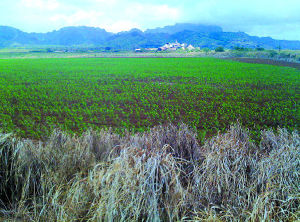 The lawsuit, filed January 11 in U.S. District Court, attempts to block Bill 2491 from coming into law (it is currently set to go into effect 9 months after its passage), and was brought forward by agrichemical company giants  DuPont, Syngenta, and Agrigenetics Inc., an affiliate of Dow Agrosciences. The suit does not come as a complete surprise to concerned residents on the island because agrichemical companies threatened litigation  as early as the bill was introduced. Advocates say that this attack by the agrichemical industry proves that these companies were never interested in finding common ground, despite attempts by local leaders to reach a compromise.
The lawsuit, filed January 11 in U.S. District Court, attempts to block Bill 2491 from coming into law (it is currently set to go into effect 9 months after its passage), and was brought forward by agrichemical company giants  DuPont, Syngenta, and Agrigenetics Inc., an affiliate of Dow Agrosciences. The suit does not come as a complete surprise to concerned residents on the island because agrichemical companies threatened litigation  as early as the bill was introduced. Advocates say that this attack by the agrichemical industry proves that these companies were never interested in finding common ground, despite attempts by local leaders to reach a compromise.
“The ordinance is invalid,” said Syngenta spokesman Paul Minehart to Reuters. “It arbitrarily targets our industry with burdensome and baseless restrictions on farming operations by attempting to regulate activities over which counties in Hawaii have no jurisdiction.”
Bill 2491 mandates companies establish reasonable buffer zones around these sensitive sites in order to protect residents against the adverse impacts of pesticide drift.  These simple, commonsense protections are intended simply to prevent incidents like the ones that occurred at Waimea Canyon Middle School in 2006 and 2007. After a number of complaints that pesticide sprayings were occurring while students were still in class, administrators and teachers sat down with Syngenta and secured an agreement from the company not to spray before school was out at 3:30 pm. Syngenta broke that promise, according to Maluhia Group, a coalition of Waimea Canyon Middle School staff, parents and community members. There’s even a YouTube video showing the event.  Hawaii’s Department of Agriculture investigated the incidents, but came to the conclusion that Cleome gynandra, known on the islands as “stinkweed”, was the main culprit. However, concerned residents are not convinced, as there have never been any recorded medical incidents of widespread poisoning by stinkweed.
One of the main arguments made by agrichemical companies is that Kauai County is preempted by state law in its ability to enact restrictions on pesticide use or GE agriculture. As Beyond Pesticides pointed out in a recent Pesticides and You article titled “State Preemption Law,” Hawaii is one of seven states that do not have regulations that would preempt local ordinances from enacting requirements more strict than the state’s. A group of attorneys from organizations including Earthjustice and the Center for Food Safety have pledged to defend Kauai’s bill at no charge.
Beyond Pesticides continues to be an ardent supporter of Kauai’s commonsense protections from pesticides and their associated use on GE crops. Given the impending approval of GE crops designed to withstand applications of the highly toxic herbicide 2,4-D, these protections are more important than ever.
Despite industry claims to the contrary, the legacy of GE agriculture has not been increased crop yields and decreased pesticide use, but instead an exponential growth of herbicide resistant weeds that require increasingly toxic pesticides in order to control. Increasing the use of toxic pesticides requires counties where, as the agrichemical company’s lawsuit states, the “climate is uniquely conducive to Plantiffs’ business” to implement increased protections, particularly around schools where children learn, hospitals where the sick need to get better, and homes where people expect to live securely in good health.
For more information on the fight for pesticide protections in the Hawaiian Islands, see Beyond Pesticides’ past Daily News articles and read Beyond Pesticides’ testimony on Bill 2491. For more information on the failed promises of GE agriculture, read “Ready or Not, Genetically Engineered Crops Explode on Market,” or see Beyond Pesticides’ website on Genetic Engineering.
Source: Reuters
All unattributed positions and opinions in this piece are those of Beyond Pesticides
Posted in Agriculture, Alternatives/Organics, Chemicals, Corporations, Dow Chemical, DuPont, Genetic Engineering, Hawaii, Litigation, Pesticide Regulation, State/Local, Syngenta by: Beyond Pesticides
1 Comment
13
Jan
(Beyond Pesticides, January 13, 2013) As medical and recreational production of marijuana in the U.S. increases, new and complicated questions have risen over how to limit consumers’ exposure to pesticides through marijuana consumption. Many growers are facing limited institutional knowledge and economic forces that could lead to the unnecessary use of pesticides. States are also still wrestling with the adequate  regulation of production and testing practices. Exposure to pesticides from marijuana consumption may also be more harmful than exposure through food consumption when consumed through inhalation. As marijuana consumption becomes more widely legalized, many are calling for  stronger safety standards for marijuana production.
Alan Schreiber, Ph.D., President of the Agriculture Development Group, believes that the legalization of recreational marijuana use in Colorado and Washington will lead to immense demand for pest prevention research. Currently, growers of marijuana lack institutional assistance from federal agencies or state agricultural extension services, which have limited understanding of marijuana production. There is a concern that the lack of  field research and increased demand may lead to heavy pesticide use.
In Washington, the state will allow the equivalent of 46 acres to be grown for recreational use, a factor that Dr.. Schreiber says will drive most production indoors. Indoor cultivation will allow for the harvest of six crops per year. This type of production system could create a “green bridge” for pests to continuously shift from older to younger crops, which would lead to intense pest pressures.
“Virtually everything they have done in the past will not be permitted going forward,” Dr. Schreiber told the Capital Ag Press.
There is also confusion about what standards will apply to the production of marijuana. As an agricultural commodity, Worker Protection Standards (WPS) will apply. If it is considered a food crop, as it is used is some edible formulations, some pesticides such as tetramethrin cannot be used in greenhouses where plants are grown for food. There are also no pesticides tolerances currently set for marijuana by the Environmental Protection Agency (EPA) because it’s illegal to grow under federal law.
States that have legalized marijuana for recreational and medical uses are still trying to determine how to best regulate pesticides used in its production. Colorado currently follows tobacco pesticide regulations to apply to marijuana production, and the packaging of the product must also label for the crop’s potency and any toxic pesticides or fungicides used in its cultivation. In Washington, over 200 pesticides have been registered by the Washington State Department of Agriculture (WSDA) under chapter 15.58 RCW for use in the production, processing, and handling of marijuana.
Only some states out of the 20 states and the District of Columbia that allow medicinal marijuana use require testing for pesticides and mold. Oregon has recently mandated testing. However, questions still remain in Oregon about how often these tests should be performed and what levels of pesticides are acceptable, Â because there are no federal tolerances set for marijuana use. Maine currently only allows 25b minimum risk pesticides (under the Federal Insecticide, Fungicide and Rodenticide Act) to be used in medical marijuana production. Â In September the operator of four of Maine’s eight medical marijuana dispensaries was fined $18,000 for using pesticides on plants in violation of state law and program rules.
Pesticide use in marijuana production has clear human health implications. During a recent presentation at Humboldt State University, Jeffrey Raber, Ph.D., reported that a study he conducted found that up to 70 percent of the pesticide residues on a marijuana bud can transfer to the smoke being inhaled. This exposure scenario is unique in that marijuana can’t be washed before it is consumed and the body has no filters for things that are inhaled, unlike food that is digested. The Eureka Times-Standard reported Dr. Raber saying that about 10 percent of tests conducted on medicinal marijuana in his lab registered positive for pesticides, and in random samples more that 35 percent failed pesticide tests. This could indicate that as marijuana undergoes increased regulatory scrutiny exposure to pesticides through inhalation could decrease.
“I think all that says is we really, really need some serious regulations within California to help us clean up our supply, especially in the medical patient context,” Dr. Raber told the Times-Standard. “These are people that are immune-compromised, they’re undergoing chemotherapy, they’re very sick with antibacterial loads. We can’t be subjecting them to more of these types of potentially harmful contaminants when they’re looking to this as a medicine source.”
Current illegal production practices of marijuana have been linked to rodenticides being found in the tissue of the fisher, a cat size carnivore that is a candidate species for listing under the Endangered Species Act (ESA). A study conducted by scientists from University of California, Davis found that the fishers’ habitat did overlap with illegal marijuana farms. The study notes that in 2008 alone law enforcement officials removed more than 3.6 million marijuana plants from federal and state public lands in California, including state and national parks. The study also found piles of bright green rodenticide pellets around the marijuana plants and along plastic irrigation lines.
The U.S. Drug Enforcement Administration (DEA) has also used toxic pesticides to control illegal marijuana production. In 1985, the DEA used glyphosate in an operation designed to kill 10,000 marijuana plants grown illegally on federal lands in the Midwest. The DEA has also used 2,4-D and paraquat in the past to stop marijuana production, which Beyond Pesticides has consistently opposed, given the threat to human health and the environment.
As support for medical and recreational marijuana increases –a new poll says that 55 percent of Americans want marijuana to be legalized nationwide, stronger pesticide regulation of marijuana production will be needed. A survey conducted by MMJ Business Daily found that 43 percent of marijuana patients said they considered the availability of organic cannabis to be “critical” when they decide where to shop for medicine. Organic standards for marijuana production are important, especially for medicinal use, as inhalation is a very direct exposure scenario.
Currently, the only way to avoid eating food grown  with  harmful synthetic pesticides by eating organic. For this and many other reasons, organic products are the right choice for consumers. For more information on organic agriculture, visit Beyond Pesticides’ Organic Agriculture program page.
Source: Capital Ag Press
All unattributed positions and opinions in this piece are those of Beyond Pesticides
Posted in 2,4-D, Agriculture, Alternatives/Organics, Chemicals, Colorado, Glyphosate, Maine, Oregon, Paraquat, Pesticide Regulation, State/Local, Washington, Wildlife/Endangered Sp. by: Beyond Pesticides
1 Comment
10
Jan
(Beyond Pesticides, January 10, 2014)  A requirement to  label genetically engineered (GE) foods in the state of Maine is set to become law. The bill, LD718, “An act to protect Maine food consumers’ right to know about genetically engineered food and seed stock,” was passed by the state legislature in July 2013 by a vote in the House of  Representatives of 141 to 4, and  with the Senates’ unanimous approval. The bill was then sent  to Governor Paul LePage (R-ME) and signed into law on Wednesday, January 8. Meanwhile, the conventional food industry is pushing legislation in Congress to prevent, or preempt,  states from adopting laws requiring labeling of GE foods.
Representatives of 141 to 4, and  with the Senates’ unanimous approval. The bill was then sent  to Governor Paul LePage (R-ME) and signed into law on Wednesday, January 8. Meanwhile, the conventional food industry is pushing legislation in Congress to prevent, or preempt,  states from adopting laws requiring labeling of GE foods.
The Maine Organic Farmers and Growers Association (MOFGA) praised the Maine law.  “We are thrilled that Governor LePage has signed the GMO labeling bill,” said MOFGA’s executive director Ted Quaday. “The time was right for a diverse and collaborative effort to take hold and move the discussion forward. People want and have the right to know what’s in their food.” Maine is the second state ””following the lead of Connecticut”” to pass labeling requirements for GE foods.
Like Connecticut’s newly passed law, Maine’s GE bill, which contains a “trigger” clause,  will only go into effect if  five  contiguous states, including the neighboring state of New Hampshire, approves a  similar measure. The New Hampshire legislature will take up similar legislation this winter.
Governor LePage made a written promise in January 2013 to the people of Maine that he would sign the bill, however, as a Republican Tea Party favorite it was unclear whether he would fulfill that commitment.  Among his first major initiatives, the governor  pledged to roll back stronger state laws on environmental quality to more lenient federal standards and halt the ban on bisphenol-A, an endocrine disruptor in baby bottles.
Mainers have expressed overwhelming support for legislation to label GE foods, with 91% favoring this legislation according to a scientific Pan-Atlantic Poll conducted in the spring of this year. Nationwide, 93% of people want foods containing GE ingredients labeled, and around 75% of consumers are worried about the effects of GE food on people’s health, according to a New York Times poll.
With Connecticut and Maine now on board with GE labeling laws, we look to other states that may also pass similar legislation. Vermont may soon join the other northeastern states that have acted, and additional ballot initiatives in the West will also play out in 2014, as GE labeling proponents have begun collecting signatures in Oregon and Colorado. A national GE labeling bill also remains in both houses of Congress, but has yet to be voted on in committee in either the Senate or the House. National GE labeling efforts are being spearheaded by the  Just Label It!  campaign. Meanwhile, Politico reported yesterday that, “The Grocery Manufacturers Association, on behalf of the food industry, is pitching to Capitol Hill lawmakers a bill that would preempt any state mandatory GMO labeling requirement by creating a voluntary labeling standard. . .” The discussion draft of the legislation, which  Politico published and industry may seek to attach to the Farm Bill on an Appropriations bill this month, would prohibit states  from  requiring GE food labeling legislation.
In the meantime, the best way to avoid food with GE ingredients is to buy organic. Under organic certification standards, GE organisms are prohibited.  For this and many other reasons, organic products are the right choice for consumers. For more information on GE foods and labeling issues, see Beyond Pesticides’  Genetic Engineering website.
All unattributed positions and opinions in this piece are those of Beyond Pesticides
Source: Portland Press Herald
Image Source: MOFGA
Posted in Agriculture, Alternatives/Organics, Announcements, Genetic Engineering, Labeling, Maine, National Organic Standards Board/National Organic Program, State/Local by: Beyond Pesticides
No Comments
09
Jan
(Beyond Pesticides, January 9, 2014) A recent CBC News analysis of  Canadian Food Inspection Agency (CFIA) data  finds that  nearly half of the organic fresh fruits and vegetables tested across Canada between September 2011 and September 2013 contained trace pesticide residues. While the fact that any amount of pesticides, trace or not, is found in organic produce may be disconcerting, the data still show that pesticides residues  at significantly higher levels are found on conventional  (chemical-intensive) counterparts. In addition to the serious health questions linked to residues of toxic pesticides on the food we eat, Beyond Pesticides, through its Eating with a Conscience database, shows that our food choices have a direct impact on the health of those who grow our food and the quality of our air, water, and land.  The  analysis in Canada and similar findings in the U.S. raise serious ongoing questions about potential adverse effects from both chemical and genetic drift or trespass that have been ignored by regulators as inconsequential.
The analysis finds that of the 45.8 percent of organic samples that tested positive for some trace of pesticide, a smaller amount ”” 1.8 per cent ”” violate Canada’s maximum allowable limits for the presence of pesticides. Among non-organic samples, 78.4 percent contain pesticide residues, violating the allowable limits 4.7 percent of the time.
U.S. Department of Agriculture (USDA) data from an earlier pilot study conducted between 2010 and 2011, which examined select samples of organic produce in various U.S. retail locations, yielded similar findings. Of the 571 samples taken between 2010 and 2011, 57 percent of the produce had no detected residues, but 43 percent contained some kind of pesticide residues, with four percent of these pesticide residues at levels above the U.S. Environmental Protection Agency (EPA) pesticide tolerance cutoffs.
USDA released this pilot study in response to a  2010 audit  of the National Organic Program by USDA’s Inspector General (IG) and later promulgated new residue testing standards for organic certifiers.
How Can Produce Be Organic and Still have Pesticides?
Many organic consumers may be scratching their heads as to how something that is labeled and approved as organic, be it in Canada or the U.S., could still be found to contain even trace amounts of pesticides. Quite literally, the answer for the majority of the pesticide residues is blowing in the wind.
“[EPA] establishes the maximum allowed levels of pesticides, or EPA tolerances, which may be present on foods. Although most EPA-registered pesticides are prohibited in organic production, there can be inadvertent or indirect contact from neighboring conventional farms or shared handling facilities. As long as the operator hasn’t directly applied prohibited pesticides and has documented efforts to minimize exposure to them, the USDA organic regulations allow residues of prohibited pesticides up to 5 percent of the EPA tolerance,” USDA explains in its Pesticide Residue Testing of Organic Produce study.
Canadian organic regulations differ slightly, but the same explanations and problems apply. “Pesticides can get onto organic produce through contamination of water or soil through pesticide spray drift from neighboring farms, and through contact with non-organic produce after harvest,” notes Rick Holley, an expert in food safety at the University of Manitoba, to CBC News.
Recognizing that the more egregious violations (those exceeding EPA tolerance levels) may reflect a need for greater enforcement of organic standards, the central problem is the abundant use of pesticides in commercial agriculture. In other words, pesticides do not obey arbitrary property lines or organic labels. The more pesticides in use in the environment, the greater the likelihood of all food eventually being contaminated at some point in the production and delivery line. This is especially true where different crops are grown in close proximity, allowing drift of chemicals from one crop to another.
Before organic consumers throw up their hands in defeat, however, it should be noted that the trace presence of pesticides on organic produce is, in fact, a central reason for supporting the growth of the  organic sector. As Matthew Holmes, executive director of the Ottawa-based Canada Organic Trade Association explained to CBC News, “I think consumers are looking for not necessarily a zero level, but they’re looking to not contribute to the pesticide residues that are out there and they’re looking to reduce their exposure as much as possible. And I still think we’re seeing in this data that organic offers that.” At the same time, as organic grows and becomes an increasingly important expectation of consumers, pressure will increase to restrict chemical-intensive and genetically engineered production systems that impose hazards without the consent of those being exposed  or penalties for those causing the unwanted pollution.
As Beyond Pesticides has emphasized through its support of the organic community and USDA organic certification process, consumer support for organic ensures that fewer pesticides are present in the environment. Buying organic supports an entire system that is conscious of the health of people, animals, and the environment. Beyond Pesticides’ Eating with a Conscience database provides a look at the toxic chemicals allowed in the production of the food we eat based on legal tolerances (or allowable residues on food commodities), and the environmental and public health effects resulting from their use. From reduced exposure to pesticides for  farmworkers  to bans on unnecessary and dangerous uses of  antibiotics  in livestock feed, choosing organic means supporting the overall well-being and health of not only yourself and family, but everyone around you. It also supports those farmers who battle both the figurative winds of conventional farming adversity and the literal winds that lead to contamination of their organic crops.
To learn more about why it is critical to continue to support organic food production and maintain the integrity of the USDA organic label, as well as organic programs in other countries, please visit our  Keep Organic Strong  webpage. For more information on the benefits of organic agriculture, see Beyond Pesticides’ Organic Food program page. To voice your support for organic integrity and comment on organic standards, practices, and allowable materials, see Beyond Pesticides’ Keeping Organic Strong webpage.
Source: CBC News
All unattributed positions and opinions in this piece are those of Beyond Pesticides.
Posted in Agriculture, Alternatives/Organics, International, Pesticide Drift by: Beyond Pesticides
1 Comment
08
Jan
(Beyond Pesticides, January 8, 2014) Last week, General Mills announced that the company will  eliminate genetically engineered (GE) ingredients from its mainstay original cereal Cheerios. The action  recognizes  the overwhelming consumer demand for GE-free products. The move was met with  a range of  reactions in the environmental community, from cheers of  victory for the GE-free movement to calls for broader action affecting General Mills’ product line, right-to-know labeling of all foods produced with GE ingredients, and compensation of farmers by patent holders of genetically engineered material that contaminates their crops.  The General Mills’ announcement does not apply to all of its Cheerio products, o r its other products.
r its other products.
“Did we change Cheerios? No. Not really,” says a blog post by Tom Forsythe, vice president of Global Communications for General Mills. “Why change anything at all? It’s simple. We did it because we think consumers may embrace it,” he continues.
Some in the environmental community assert that this change is an attempt by the company to revive its image after spending millions of dollars to defeat state-level labeling initiatives in California in 2012, and Washington State in 2013. The ”˜new’ Cheerios will contain the label “Not Made with Genetically Modified Ingredients.”  General Mills’ move to label its most popular brand of cereal undercuts one of the main arguments used by opponents of GE labeling, namely that changing to non-GMO food ingredients is not economically feasible.
Despite the company’s tepid adjustment, the news does help to increase public awareness of GE food in the modern American diet, where nearly 80% of food items sold on supermarket shelves contain GE ingredients. This is important because without adequate labels consumers cannot determine whether the products they purchase do in fact contain these ingredients. And by and large, American consumers are calling for policies to adequately address the GE labeling issue. According to a New York Times poll conducted last year, 93% of people want foods containing GE ingredients labeled, and around 75% of consumers are worried about the effects of GE food on people’s health.
Last year, the  grocery chain Whole Foods announced it would require labels on GE products by 2018, and supermarket rival Trader Joe’s already proclaims that it sells no products containing GE ingredients at its stores. Grassroots pressure pushed the introduction of GE labeling legislation in over 25 states last year, and while Maine and Connecticut passed labeling bills,  they contain a  “trigger clause” that delays implementation until  similar legislation is passed in neighboring states, including one bordering state in the case of Connecticut,  with an aggregate population of 20 million. Vermont may soon come on board, and additional ballot initiatives in the West will also play out in 2014, as GE labeling proponents have begun collecting signatures in Oregon and Colorado. A national GE labeling bill also remains in both houses of Congress, but has yet to be voted on in committee in either the Senate or the House.
Consumers have a right to know whether the foods they buy contain GE ingredients not only because of concerns over the safety of eating GE food, but also because of the direct and indirect effects of GE agriculture on the environment, wildlife, and the human health. In the Hawaiian islands, counties are taking a stand against GE agriculture that has led to widespread poisoning of sensitive environmental sites and entire communities. Associated with GE agriculture is the increased use of herbicides that GE crops are developed to tolerate. Repeated spraying of these herbicides, particularly glyphosate, the active ingredient in Roundup, destroys refuge areas for beneficial insects such as the Monarch butterfly, directly harms amphibians, and leads to resistance in weed species the GE technology was intended to control. The failure of GE technology was highlighted earlier this week as USDA released a Draft Environmental Impact Statement for GE corn and soybeans engineered to tolerate the toxic herbicide 2,4-D. With glyphosate resistance rampant, the agrichemical industry continues to resort to increasingly toxic combinations of chemicals, despite the presence of organic management practices that are  more protective of human health and the environment and produce the same yield. Thus, for a multitude of reasons, consumers have the right to know the ingredients in the products they are purchasing.
General Mills has shown that it is economically viable to change the label on its products and provide consumers with information about GE ingredients. With increased public pressure, the company may take a larger, more substantive step and apply this policy to all its products, and support policies that would require other protections from genetically engineered organisms. In the meantime, consumers can purchase foods produced without GE organisms by seeking out the U.S. Department of Agriculture (USDA) Certified Organic Seal. Under organic certification standards, genetically modified organisms and their byproducts are prohibited. For many other reasons, organic products are the right choice for consumers.
All unattributed positions and opinions in this piece are those of Beyond Pesticides.
Source: GeneralMills.com, AlJazeera America
Image Source: Flikr
Posted in Agriculture, Corporations, Genetic Engineering by: Beyond Pesticides
1 Comment
07
Jan
(Beyond Pesticides, January 7, 2014) An Oregon state representative, Rep. Jeff Reardon (D-Portland), plans to introduce legislation in February that will effectively ban for home and garden use  certain neonicotinoid pesticides implicated in mass bee deaths this  summer. This legislation is part of the growing national effort to ban or restrict the use of neonicotinoid pesticides. Last year, the Save America’s Pollinators Act was introduced by Representative Earl Blumenauer (D-OR) to ban the use of neonicotinoids nationally.
Rep. Reardon’s legislation would add neonicotinoid pesticides dinotefuran, imidacloprid, clothianidin and thiamethoxam to Oregon’s restricted pesticide use list. Under Oregon’s pesticide administrative rules,restricted use pesticides can only be applied by licensed pesticide applicators. Pesticide dealers are also required  to keep records of product sales of these pesticides and maintain sales records for at least three years. The legislation would also require the state to implement special training and testing to ensure licensed pesticide applicators know how to minimize risk to  pollinators. 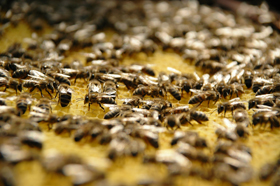
“These are dangerous chemicals. People who aren’t willing to take the time and effort to become fully educated should look for alternatives,” Rep. Reardon told The Oregonian.
Though this legislation would limit the amount of neonicotinoid pesticides directly applied to lawns and ornamental plants, it does not address the sub-chronic effects neonicotinoid pesticides have on pollinators when the chemicals are used as a seed coating. Neonicotinoids are systemic, meaning that as the plant grows  the pesticide becomes incorporated into the plant. When honey bees and other pollinators forage and collect pollen or nectar, or drink from what are termed “guttation” (water) droplets emitted from neonicotinoid-incorporated crops, they are exposed to sublethal doses of the chemical. At this level the pesticides don’t kill bees outright. Instead, they impair bees’ ability to learn, to find their way back to the hive, to collect food, to produce new queens, and to mount an effective immune response.
A Â pilot study, co-released by Beyond Pesticides, found that 7 of 13 samples of garden plants purchased at top retailers in Washington DC, the San Francisco Bay Area and Minneapolis contain neonictinoids which that come from the use of treated seeds. This study is particularly alarming because homeowners who wanted to provide plant habit for pollinators may have unwittingly exposed them to harmful pesticides if they purchased plants at these garden stores.
This possible legislation comes after two massive bee deaths were recorded in two different Oregon towns in June. An estimated  50,000 bumblebees, likely representing over 300 colonies, were found dead or dying in Wilsonville which was the largest known incident of bumblebee deaths ever recorded in the U.S. After a preliminary investigation, the Oregon Department of Agriculture (ODA) confirmed that the massive bee die-off was caused by the use of the insecticide  dinotefuran. Then, it was reported by  The Oregonian  that hundreds of bees were found dead after the same pesticide was used in the neighboring town of Hillsboro.
After these massive bee die offs, ODA placed temporary restrictions on the use of pesticides that contained dinotefuran. The rule even applied to licensed applicators and making an application of dinotefuran could have resulted in the revocation of an applicator’s license or the imposition of a civil penalty. However, this past November ODA removed these temporary restrictions and limited the ban on the use of dinotefuran and clothianidin specifically to linden trees, basswood, and other trees of the Tilia genus.
Beyond Pesticides through its BEE Protective campaign works with national and local groups to protect honey bees and other pollinators from pesticides and contaminated landscapes. As part of this campaign, Beyond Pesticides is working with consumers to demand that Lowes and Home Depot stop selling neonicotinoid pesticides and plants that are grown from neonicotinoid-treated seeds. You can sign our petition here. Beyond Pesticides is also a part ofa coalition-based  national advertising campaign  to raise awareness of pollinator declines and urge EPA to stop stalling by enacting substantive restrictions on the use of bee-harming pesticides. To support our efforts to restrict bee-toxic pesticides, visit  save-bees.org  and sign the petition to EPA Administrator Gina McCarthy.
Additionally, Beyond Pesticides’ 32nd National Pesticide Forum, Advancing Sustainable Communities —People, pollinators and practices, will take place in Portland, Oregon April 11-12, 2014. The annual conference will be held at Portland State University in conjunction with Northwest Center for Alternatives to Pesticides and Portland State University’s Institute for Sustainable Solutions.  Issues in  Oregon, the northwest, and nationally, including  pollinator protection, pesticide use in forestry, and  GE labeling and contamination, will be key topics at the upcoming Forum and we hope to see you there!  For more information, see the National Pesticide Forum website.
Source: The Oregonian
 All unattributed positions and opinions in this piece are those of Beyond Pesticides.
Posted in Chemicals, Clothianidin, dinotefuron, Imidacloprid, Oregon, Pesticide Regulation, Pollinators, State/Local, Thiamethoxam by: Beyond Pesticides
No Comments
06
Jan
(Beyond Pesticides, January 6, 2014) The U.S. Department of Agriculture (USDA) Friday released for public input its Draft Environmental Impact Statement (DEIS), which calls for the deregulation of genetically engineered (GE) corn and soybeans engineered to be tolerant to the toxic herbicide 2,4-D. These new varieties of GE corn and soybean, created partly due to proliferate weed resistance resulting from the widespread use of glyphosate (Roundup) on other GE crops, is set to usher in dramatic increases in 2,4-D use with associated health and environmental hazards, according to environmental scientists. The GE crops are being produced by Dow AgroSciences under the brand name “Enlist.”
According to Nichelle Harriott, senior scientist at the national environmental group Beyond Pesticides, “The engineered varieties will not only spawn new weed resistant strains, but contaminate the environment and increase the public health risks to cancer and Parkinson’s disease, especially in farmworkers and farming communities exposed to 2,4-D.”
The failure of GE-glyphosate (Roundup) tolerant crops to live up to their promises is a main contributing factor behind the development of stacked varieties such as “Enlist,” which combines resistance to 2,4-D and glyphosate. So widespread is glyphosate resistance that EPA has granted emergency use exemptions for pesticides without registered uses in agriculture, like fluridone. One 2012 report shows that GE crops have been responsible for an increase of 404 million pounds of pesticide, or about 7%, in the U.S. over the first 16 years of commercial use of GE crops (1996-2011), which means that 2,4-D use is expected to increase dramatically in GE fields.
While USDA attempts to assure the public that 2,4-D is safe, the science has raised serious concerns about the safety of this herbicide, which was used as a key ingredient in “Agent Orange,” used to defoliate forests and croplands in the Vietnam War. Scientists around the world have reported increased cancer risks in association with its use, especially for non-Hodgkins Lymphoma (NHL). It is also neurotoxic, genotoxic, and an endocrine disruptor. Studies have also reported that occupational exposure to 2,4-D is associated with an increased risk of Parkinson’s disease.
The proposed deregulation of these GE crops is being met with criticism from farmers, environmentalists and other concerned groups. Similar to previous decisions to deregulate other varieties of GE soybeans, alfalfa, and sugar beets, safety advocates charge that USDA fails to take into account several scientifically-validated environmental concerns, such as the indiscriminate nature of GE gene flow among crops, a heavy reliance on faulty data, and a high degree of uncertainty in making safety determinations. Deregulation of 2, 4-D GE corn and soybeans also underplays the issue of 2,4-D drift that has been a  documented problem to off-site locations, endangered species and non-target crops, as well as the threat of dioxin contamination.
The agency once again overlooks the problem of herbicide-resistant weeds (and insect resistance to engineered “plant incorporated protectants”)  , and the widespread corruption of conventional seed varieties by GE strains, along with documented severe health and economic injury to non-GE and organic farmers and markets. In  Southern states, glyphosate-resistant horseweed, ryegrass and pigweed are a concern for soybean farmers, while resistant  horseweed and volunteer Roundup Ready soybeans have become problem weeds for Mississippi rice. In Australia, weed scientists have now documented cases of glyphosate resistance in rigid ryegrass across large areas and are encountering it in other weed species in different parts of the world.
Instead of chemical-intensive and  genetically engineered  strategies that exacerbate weed and insect problems, USDA should only allow  sustainable, integrated pest management strategies, including organic practices, to minimize and even avoid the production challenges that most GE organisms have been falsely-marketed as solving. These strategies can also help farmers get off the pesticide treadmill which constantly demands greater amounts of synthetic inputs.
“In the age of organic agriculture it is irresponsible to be introducing a failed technology reliant on 2,4-D with all its known hazards to human health and the environment,” said Jay Feldman, executive director of Beyond Pesticides.
For more information on the environmental hazards associated with GE technology, visit Beyond Pesticides’  Genetic Engineering webpage. The best way to avoid genetically engineered foods in the marketplace is to purchase foods that have the U.S. Department of Agriculture (USDA) Certified Organic Seal. Under organic certification standards, genetically modified organisms and their byproducts are prohibited.  For many other reasons, organic products are the right choice for consumers.
All unattributed positions and opinions in this piece are those of Beyond Pesticides.
Source: USDA
Posted in 2,4-D, Agriculture, Alternatives/Organics, Chemicals, Genetic Engineering, National Politics, Pesticide Regulation, Resistance by: Beyond Pesticides
4 Comments
03
Jan
(Beyond Pesticides, January 3, 2014) A recent study on the European corn borer (ECB), a major corn pest, finds no significant difference in yield between genetically engineered (GE)Bt (ECB-resistant) corn and non-GE corn in the Northeast, where pest pressure has decreased. Considering the high cost of GE corn, researchers determine that farmers will see no benefits in terms of profit. The study, published in the journal Pest Management Science, examines the damage that ECBs cause to crops, comparing corn genetically engineered to express the insecticidal toxin Bacillus Thuringiensis (Bt) with non-Bt crops at 29 sites around Pennsylvania over three years.
The study concludes that although Bt corn hybrids reduced ECB damage in comparison to non-Bt crops, they found no difference in yields, explaining that because of higher seed costs they also “rarely improved profits.” Although researchers attribute the decline in ECB population to the adoption of Bt corn, the study does not address long-term insect resistance which can develop in fields after the introduction of GE crops and lead to an increased use in pesticides.
“With less ECB damage around, non-Bt hybrids in our tests yielded just as well as Bt hybrids, so the decline in ECB populations provides an opportunity for growers to generate greater profits by planting high-yielding non-Bt seed, which is much cheaper than Bt seed,” said Eric Bohnenblust, graduate student and co-author of the study, to Penn State News. “Planting more non-Bt corn will [also] reduce the potential for ECB to develop resistance to Bt toxins as corn rootworms have done in about a dozen states so far.”
The researchers suggest that farmers should consider planting non-Bt corn as a cost-cutting measure,and conclude that “Bt hybrids remain valuable control options.” However, there is  mounting evidence demonstrating insect resistance, crop contamination, and potential adverse impacts of GE crops to human health and the environment.
Indeed, in 2011 entomologists at Iowa State University  published a study  verifying the first field-evolved resistance of another corn pest, corn rootworm, to a Bt toxin. The study found the western rootworm’s ability to adapt was strongest in fields where Bt corn was planted for three consecutive years and suggested that insufficient planting of refuges may have contributed to the resistance. This study was cited by a group of 22 prominent entomologists who submitted formal comments to the EPA, identifying significant flaws in current practices for managing insect resistance to Bt corn and cautioning that failure to implement alternative measures would result in all forms of Bt losing its effectiveness. Similarly, a 2013 study by University of Illinois researchers found corn rootworm to be resistant to GE Bt corn within two of Illinois’ counties, causing severe damage to those crops.
The European corn borer causes severe damage to the corn in the larval stage. As larvae emerge from overwintering, they feed and tunnel within the tassel, ear, and stem forming cavities within the crop. This boring damage weakens the plant, diminishing yields as the plant becomes unable to transport water and nutrients through the damaged stalk. Previous research in Pennsylvania suggests that ECB was responsible for about a 5.5% yearly yield reduction in field corn. Extensive yield losses from reduced leaf area, broken stalked, dropped years, and stalk rot, caused by ECB and corn rootroom led to widespread use of Bt-corn. Research here suggests however, that these yield gains are no longer being made, and farmers should consider planting non-Bt corn.
Genetically engineered crops not only facilitate insect resistance but also threaten the sustainability of organic agriculture. There has long been a concern that EPA’s allowance of plant incorporated protectants (PIPs) with Bt would lead to the failure of a biological tool used in organic farming systems as an alternative to highly toxic synthetic inputs. Organic farmers have expressed concern since the introduction of PIPs in 2003 that the overuse of Bt, which is inevitable when Bt is genetically engineered into every cell of a plant, will lead to insect resistance and leave many farmers without an important tool of organic agriculture.
Organic agriculture is the last sustainable refuge from genetically engineered crops.  It represents an ecologically-based management system that prioritizes cultural, biological, and mechanical production practices and natural inputs by strengthening on-farm resources, such as soil fertility, pasture and biodiversity.  For more reasons to support organic agriculture, visit Beyond Pesticides’ Why Organic page.
Source: Science Daily, Pest Management Science
All unattributed positions and opinions in this piece are those of Beyond Pesticides.
Posted in Agriculture, Alternatives/Organics, Bt, Chemicals, corn rootworm, Genetic Engineering, Pests, Resistance by: Beyond Pesticides
No Comments
02
Jan
(Beyond Pesticides, January 2, 2014) Near the conclusion of 2013, the U.S. Environmental Protection Agency (EPA) announced a settlement agreement with a Florida-based pesticide producer and distributor, Harrell’s LLC. Alleging multiple violations of the Federal Insecticide, Fungicide, and Rodenticide Act (FIFRA), the agreement requires Harrell’s to pay a hefty civil penalty in the amount of $1,736,560.
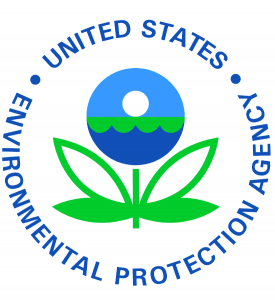 Under FIFRA, the nation’s primary law governing the manufacture, distribution, and use of pesticides, a pesticide product cannot enter the U.S. marketplace without EPA registration and an approved label that conveys to intended users of the product critical information about its contents, methods and areas of application, and potential hazards. Ideally, the purpose of FIFRA is to ensure that no pesticides are produced, imported, distributed, sold, or used in a manner that pose an “unreasonable risk” to human health or the environment.
Under FIFRA, the nation’s primary law governing the manufacture, distribution, and use of pesticides, a pesticide product cannot enter the U.S. marketplace without EPA registration and an approved label that conveys to intended users of the product critical information about its contents, methods and areas of application, and potential hazards. Ideally, the purpose of FIFRA is to ensure that no pesticides are produced, imported, distributed, sold, or used in a manner that pose an “unreasonable risk” to human health or the environment.
While there are a number of loopholes and weaknesses in this system, such as conditional registrations, that lead to toxic products entering the marketplace without a full understanding of the potential health hazards and environmental risks associated with those products, FIFRA’s protections are at their core dependent on diligent adherence to the registration and labeling rules.
Any product that does not adhere to the strict labeling standards is deemed “misbranded.”  As EPA explains in its Consent Agreement and Final Order (CAFO), “The FIFRA prohibition against the distribution or sale of misbranded pesticides is important because it helps ensure that end users and members of the public have the most accurate, up-to-date, and compliant information available about pesticides in the marketplace.”
According to the allegations in the CAFO, beginning as early as 2009, Michigan-state inspectors discovered multiple violations of FIFRA at the Harrell’s Michigan facility.  These violations included nine separate Harrell’s pesticide products missing key labeling information, such as precautionary statements, personal protection equipment requirements, user safety requirements, directions for use, environmental hazards statements, and storage and disposal directions.
A few year later in 2012, state-inspectors from Massachusetts, Connecticut, Alabama, Indiana, and two separate EPA regions discovered additional misbranding violations on Harrell’s products as well as products of Dow, Bayer, and DuPont for which Harrell acted as a supplemental distributor. The increased inspections revealed that in addition to the 21 pesticides products that had been distributed with absent or illegal labels, inspectors also discovered that Harrell’s operated an unregistered pesticide production facility. After Harrell’s ignored  two EPA stop-sale orders for these violations (another violation under FIFRA in and of itself), EPA proceeded with the enforcement action.
No Label No Worries?
Think a missing label is no big deal? Taking a look at the Material Data Safety Sheets (MSDSs) for the 21 pesticide products that were found to have labels entirely absent or illegible on at least 365 separate occasions might change your mind. For example, Merit lists imidacloprid as its most prominent hazardous ingredient. A part of a class of insecticides known as neonicotinoids, even proper use of this pesticide presents significant dangers to beneficial insects, such as honeybees, which are facing unprecedented population decline. Couple that with its potential reproductive effects, toxicity to fish and other aquatic organisms and it becomes clear that a missing label presents significant hazards to both people and the environment.
The Numbers and the New Year
According to EPA’s Press Release, the civil penalty is one of the largest ever for an enforcement case under FIFRA. And while $1.7 is an impressive number in the realm of FIFRA civil penalties, EPA’s reported FIFRA enforcement actions for the year are disappointing. In 2013, EPA lists only three FIFRA-related civil cases and settlements on its enforcement webpage. Compare that to 2012’s whopping 24 actions or even 2011’s nine and the number seems even smaller.
Granted, the majority of FIFRA enforcement responsibilities are delegated to state authorities.  Thus when smaller enforcement actions do arise, they often do not reach the desks of EPA’s enforcement agents, data compilers, or media relations staffers.  Even within EPA there are most likely reporting inconsistencies and, of course, there is always the argument that a few big cases targeting national companies (such as Walmart) and levying significant fines have more impact than a bunch of smaller cases.
Recognizing all of these factors, the number””three””not $1.7 million, is one that should draw the attention of the public and invite a pensive pause.  In the realm of pesticide protective frameworks, FIFRA is not a strong law be any stretch of the imagination.  It does not impose strong tracking and reporting requirements, it establishes relatively weak safety thresholds for a product’s entry into the marketplace, and, as demonstrated by the Harrell’s case, relies heavily on the producers and users of the pesticides to following instructions for any of its safety measure to work.
Without state authority and EPA oversight and enforcement, the public is placed in a perilous position.  Beyond Pesticides applauds any enforcement actions that reduce illegal and unsafe exposures to pesticides, but advocates urge EPA to take a more dedicated role in ensuring that wherever possible, FIFRA violators, big or small, do not go unchallenged.  Beyond Pesticides encourages EPA to set new safety standards for 2014 that utilize FIFRA’s protective frameworks to their fullest capacity and make our environment, homes, and families a little bit safer from pesticides.
Sources: EPA
All unattributed positions and opinions in this piece are those of Beyond Pesticides.
Posted in Chemicals, Imidacloprid, Label Claims, Litigation, National Politics, Pesticide Regulation by: Beyond Pesticides
No Comments
24
Dec
Beyond Pesticides wishes our members and supporters a happy, healthy, and organic holiday season and New Year! Our Daily News is taking a holiday break and will return on Thursday, January 2, 2014 with renewed energy and vision to continue making real change in communities across the the U.S. and around the world.
We look forward to working with you to make 2014 a safe, pesticide-free year for you, your family, and your community at large. We would like to deeply thank our members and supporters for an amazing 2013 that was filled with so many accomplishments and milestones for the pesticide-free movement.
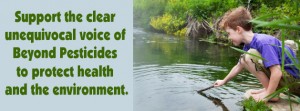 Yet, there are still many areas where our collective voice is needed to put pressure on decision makers to take action for the protection of human health and the environment. We plan to increase our efforts in 2014 to provide communities with the assistance that is needed to broaden the adoption of the exciting changes that are taking hold throughout the country. At the same time, we urge all those who are able to help us increase the strength of our voice and our assistance program by providing a charitable donation to Beyond Pesticides.
Yet, there are still many areas where our collective voice is needed to put pressure on decision makers to take action for the protection of human health and the environment. We plan to increase our efforts in 2014 to provide communities with the assistance that is needed to broaden the adoption of the exciting changes that are taking hold throughout the country. At the same time, we urge all those who are able to help us increase the strength of our voice and our assistance program by providing a charitable donation to Beyond Pesticides.
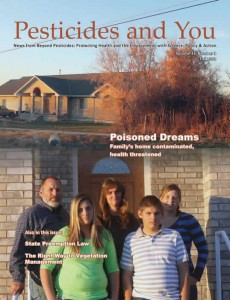 With a $150 donation, we send you our BEE Protective Kit, which includes our Habitat Guide and a Pesticide Free Zone sign and owner’s manual. You can also give the gift of membership or become a Beyond Pesticides member yourself! Membership in Beyond Pesticides provides you with a year-long subscription to Pesticides and You, our quarterly newsletter that gives in-depth discussion and analsis of the latest news, science, and policy on pesticide issues by Beyond Pesticides staff and experts in the field.
With a $150 donation, we send you our BEE Protective Kit, which includes our Habitat Guide and a Pesticide Free Zone sign and owner’s manual. You can also give the gift of membership or become a Beyond Pesticides member yourself! Membership in Beyond Pesticides provides you with a year-long subscription to Pesticides and You, our quarterly newsletter that gives in-depth discussion and analsis of the latest news, science, and policy on pesticide issues by Beyond Pesticides staff and experts in the field.
Our Fall 2013 Pesticides and You is now online. We hope you will read Poisoned Dreams, the story of the Frandsen family of Utah, who were poisoned by the pesticide business next-door to their home. Their story epitomizes the failure of regulators to adequately address the hazards associated with the cradle-to-grave impacts of pesticide use. The Frandsen’s did everything they could to find relief from those in government tasked with protecting human health, yet were met with indifference and disregard. Their message to all of us is a message for the protection of health and the environment.
Stories such as the Frandsen’s are why Beyond Pesticides works to change policies and practices that cause unnecessary harm. It is why we push to promote safer alternatives in the marketplace through organic practices. If safe, effective alternatives to pesticides are available, we can move beyond, as communities such as Takoma Park, MD, and Kauai County, Hawaii told us in 2013.
 Takoma Park, MD, not subject to regressive state pesticide preemption laws, successfully passed a landmark ordinance restricting pesticide use on both public and private property. The policy was moved forward by two concerned moms, each fighting for the health and safety of their children. Their accomplishment inspires all of us to push for pesticide protections in our own communities in 2014. Beyond Pesticides is here to support you, and arm you with the facts on pesticide hazards and alternatives.
Takoma Park, MD, not subject to regressive state pesticide preemption laws, successfully passed a landmark ordinance restricting pesticide use on both public and private property. The policy was moved forward by two concerned moms, each fighting for the health and safety of their children. Their accomplishment inspires all of us to push for pesticide protections in our own communities in 2014. Beyond Pesticides is here to support you, and arm you with the facts on pesticide hazards and alternatives.
 In “The Garden Isle” of Kauai, Hawaii we saw a massive outpouring of support for new laws to rein in giant agrichemical companies that are wrecking the island and its inhabitant’s health. Limits on pesticide use and genetically engineered crop production will provide basic protections that agrichemical companies fought tooth and nail to prevent. And now, because of Kauai’s lead, Maui and Hawaii County (“The Big Island”) have taken their own steps towards increased protections from pesticides and genetically engineered crops. We’re up against powerful interests, but your actions can change the outcome.
In “The Garden Isle” of Kauai, Hawaii we saw a massive outpouring of support for new laws to rein in giant agrichemical companies that are wrecking the island and its inhabitant’s health. Limits on pesticide use and genetically engineered crop production will provide basic protections that agrichemical companies fought tooth and nail to prevent. And now, because of Kauai’s lead, Maui and Hawaii County (“The Big Island”) have taken their own steps towards increased protections from pesticides and genetically engineered crops. We’re up against powerful interests, but your actions can change the outcome.
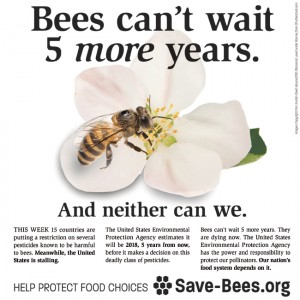 The decline of pollinators reveals how high the stakes are in our efforts to protect the environment and food supply. We need your continued support in 2014 to get regulators, retailers, and politicians to take action and protect honey bees and other wild pollinators by stopping the unnecessary use of neonicotinoid pesticides. Beyond Pesticides launched the BEE Protective campaign in 2013 to educate the public and support local action aimed at protecting honey bees and other pollinators from pesticides and contaminated landscapes. And, we ran a full page ad in newspapers across the country with the message to regulators at the Environmental Protection Agency: “Bees can’t wait 5 more years. And neither can we“With the start of restrictions on neonicotinoid pesticide use in the European Union, and new evidence that these chemicals also harm the development of young children, it is imperative that EPA acts to restrict these pesticides for the sake of both pollinators and human health
The decline of pollinators reveals how high the stakes are in our efforts to protect the environment and food supply. We need your continued support in 2014 to get regulators, retailers, and politicians to take action and protect honey bees and other wild pollinators by stopping the unnecessary use of neonicotinoid pesticides. Beyond Pesticides launched the BEE Protective campaign in 2013 to educate the public and support local action aimed at protecting honey bees and other pollinators from pesticides and contaminated landscapes. And, we ran a full page ad in newspapers across the country with the message to regulators at the Environmental Protection Agency: “Bees can’t wait 5 more years. And neither can we“With the start of restrictions on neonicotinoid pesticide use in the European Union, and new evidence that these chemicals also harm the development of young children, it is imperative that EPA acts to restrict these pesticides for the sake of both pollinators and human health .
.
But when EPA does act, like the agency did on toxic rodenticides and children’s health earlier this year, we must stand up, defend, and support EPA efforts. Despite the agency’s determination that 12 “d-CON” rodenticide products pose “unreasonable adverse effects on the environment,” the manufacturer, Reckitt Benckiser, made an almost unprecedented move and sued EPA to keep the products on store shelves. Beyond Pesticides is asking retailers this holiday season to care about kids, and stop the sale of toxic rodenticides that endanger children, pets, and wildlife.
 In 2014, we should also strengthen and maintain the integrity of those government programs that support our vision for a healthier future. Your voice in organic made a difference this year, as the widespread public outcry from the organic community led to the phase-out of the antibiotic tetracycline in organic apple and pear production. Yet, recent changes to the sunset review process puts organic integrity at risk. Please continue to follow Beyond Pesticides’ actions and alerts on organic agriculture and provide a public comment at the next NOSB meeting, to be held April 29-May 1, 2014 in San Antonio, Texas. Your continued support will be critical in helping us keep the organic label strong.
In 2014, we should also strengthen and maintain the integrity of those government programs that support our vision for a healthier future. Your voice in organic made a difference this year, as the widespread public outcry from the organic community led to the phase-out of the antibiotic tetracycline in organic apple and pear production. Yet, recent changes to the sunset review process puts organic integrity at risk. Please continue to follow Beyond Pesticides’ actions and alerts on organic agriculture and provide a public comment at the next NOSB meeting, to be held April 29-May 1, 2014 in San Antonio, Texas. Your continued support will be critical in helping us keep the organic label strong.
Beyond Pesticides brings all of our work together and connects intimately with scientists, activists, and politicians in local communities through our National Pesticide Forum. The 31st National Pesticide Forum, held in 2013 at the University of New Mexico, brought together top national scientists with local and national activists to craft solutions and catalyze networks to advance positive health and environmental policy and change. If you haven’t read or vie wed the keynote address, “Protecting Life: From Research to Regulation“ by Dr. Tyrone Hayes, we strongly encourage you to take the time.
wed the keynote address, “Protecting Life: From Research to Regulation“ by Dr. Tyrone Hayes, we strongly encourage you to take the time.
Be aware, Dr. Hayes work is under threat due to exceedingly high fees from his university’s Office of Laboratory and Animal Care. In response, Beyond Pesticides launched The Fund for Independent Science in 2013 to support Dr. Hayes’ work to protect life from harmful chemicals. To date, Beyond Pesticides has helped to raise $112,000 to support Dr. Hayes research. In addition to your support of Beyond Pesticides’ program, please consider a pledge to support independent science so that Dr. Hayes’ critical work can continue throughout 2014.
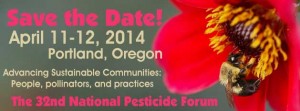 In 2014, the 32nd National Pesticide Forum, Advancing Sustainable Communities —People, pollinators and practices, will take place in Portland, Oregon at Portland State University. With so many issues rising up in need of action in Oregon that are intimately connected to the national movement, including pollinator protection, pesticide use in forestry, GE labeling and contamination, we hope to see you there. Stay tuned to the National Pesticide Forum website for updates on speakers and the schedule of events.
In 2014, the 32nd National Pesticide Forum, Advancing Sustainable Communities —People, pollinators and practices, will take place in Portland, Oregon at Portland State University. With so many issues rising up in need of action in Oregon that are intimately connected to the national movement, including pollinator protection, pesticide use in forestry, GE labeling and contamination, we hope to see you there. Stay tuned to the National Pesticide Forum website for updates on speakers and the schedule of events.
Thank you all again for raising your voice for health in 2013, we’re so excited to see what we can accomplish with your support in the New Year.
 All unattributed positions and opinions in this piece are those of Beyond Pesticides.
Posted in Announcements, Holidays, Take Action by: Beyond Pesticides
No Comments
23
Dec
Beyond Pesticides, December 23, 2013) The Environmental Protection Agency (EPA) and the National Oceanic and Atmospheric Administration (NOAA)  in a  Federal Register notice  has found that the state of Oregon’s program to reduce nonpoint coastal pollution is inadequate. Both federal agencies state that Oregon’s program does not adequately protect streams that provide habitat for Coho Salmon, an endangered species, and drinking water from herbicides that are aerially sprayed by lumber companies. This notice comes just after a recent report was released by Beyond Toxics on the health and environmental problems caused by aerial herbicide application on timber forests near Triangle Lake.
EPA and NOAA’s proposed disapproval action of Oregon’s Coastal Nonpoint Program finds that the state has failed to adequately protect certain waterways within the state. Under the Coastal Zone Act Reauthorization Amendments (CZARA) of 1990, states are required to submit an approvable Costal Nonpoint Pollution Control Program to NOAA and EPA. In 1998, federal agencies approved the Oregon Nonpoint Program with conditions that the state meet certain water pollution issues. This proposed disapproval action is part of a settlement of a lawsuit brought by the Northwest Environmental Advocates in 2009, which charged Oregon has failed to meet the conditions of the Oregon Nonpoint Program’s approval. The federal agencies specifically found that the state did not meet the required conditions in three areas –storm water management, pollution from drain and leaky septic systems, and forestry practices.
In the area of forestry practices, the federal agencies found that Oregon’s forest practice rules, which require buffer zones for most pesticide applications,  did not address aerial applications of herbicides on non-fish bearing streams. These streams comprise a significant portion of the total stream length in the coastal nonpoint management area. For small, non-fish bearing streams, Oregon’s coastal nonpoint program submission relies on the state’s Pesticide Control Law at ORS 634, OAR 603-57, which requires best management practices set by the Oregon Department of Agriculture (ODA) and the Federal Insecticide, Fungicide, and Rodenticide Act (FIFRA). However, the disapproval action states that as  a result of a 2007 lawsuit, which enforces a legal requirement that  EPA consult with the National Marine Fisheries Service (NMFS), certain herbicides  registered under FIFRA have been found through recent biological opinions (BiOps) to jeopardize certain listed endangered species.
The proposed disapproval action suggests that Oregon should expand its Pesticide Stewardship Partnership (PSP) monitoring program to watersheds that are within costal nonpoint management areas. The federal agencies are also encouraging Oregon to design its monitoring program in consultation with EPA and NMFS so that it generates data that are also useful for EPA pesticide registration reviews and new BiOps.
This proposed disapproval action also opens the agriculture conditions of the Oregon Coastal Nonpoint Program, which were approved in 2004, for public comment. According to the agencies, there is concern that water quality may be impaired from agricultural contaminants, such as nutrient and pesticide runoff, due to insufficient riparian buffers.
This proposed disapproval action comes just after Beyond Toxics released its report, Oregon’s Industrial Forests and Herbicide Use: A Case Study of Risk to People, Drinking Water and Salmon, which is an  in-depth analysis of industrial forestry pesticide application records for the State of Oregon. The report focuses on the use of herbicides on 184,320 acres of private industrial and state forestlands surrounding Triangle Lake, a rural area in western Lane County, Oregon.
In 2011, atrazine and 2,4-D were found in the urine of residents around Triangle Lake. After these incidents, state and federal agencies launched the Highway 36 Corridor Public Health Exposure Investigation. The investigation resulted in the Oregon State Forester requiring pesticide applicators to turn over three years of forestry pesticide spray records from private and state timber operations, to which Beyond Toxics was given access. Beyond Toxics’ report contains several alarming findings. The report found that chemical regulations under the Oregon Forest Practices Act are weaker than regulations in Washington and Idaho. Unlike its neighboring states, Oregon has no spray buffers around homes, schools and farms, and has no protections of groundwater. The report also finds that the number of aerial sprays and pounds of pesticides applied per acre increased from 2009 to 2011, and that aerial sprays occurred directly over headwaters of protected Coho Salmon streams.
Even more troubling, the report finds that applicators use tank mixes of herbicides that contain two to five active ingredients and adjuvant products, despite a lack of understanding about synergistic effects of multiple chemicals combined and released into the environment. The report also strongly connects the pesticides found in the urine of Triangle Lake residents in 2011 with pesticides used in aerial applications. According to the report, the  pounds of 2, 4-D and atrazine applied by aerial spray increased by 80 percent and 73 percent in 2011.
Beyond Pesticides has long advocated for healthier and more  environmentally friendly forestry practices. On a promising note, the U.S. Forest Service, the other major timber grower in Oregon, gave up nearly all herbicide use in the northwest back in the 1980s. Making this transition is economically possible, according to Jim Furnish, who managed the Siuslaw National Forest in Oregon in the 1990s. “It was more costly, more labor intensive. But forestry in Oregon is profitable under many different scenarios,” said Mr. Furnish, who later became deputy chief of the Forest Service. “The Forest Service just saddled itself to a different horse and rode off into the future.”
Source: The Oregonian
Image Source: Wikipedia.org
 All unattributed positions and opinions in this piece are those of Beyond Pesticides.
Posted in 2,4-D, Agriculture, Atrazine, Chemicals, Litigation, Oregon, Pesticide Regulation, State/Local, Water, Water Regulation, Wildlife/Endangered Sp. by: Beyond Pesticides
1 Comment


































